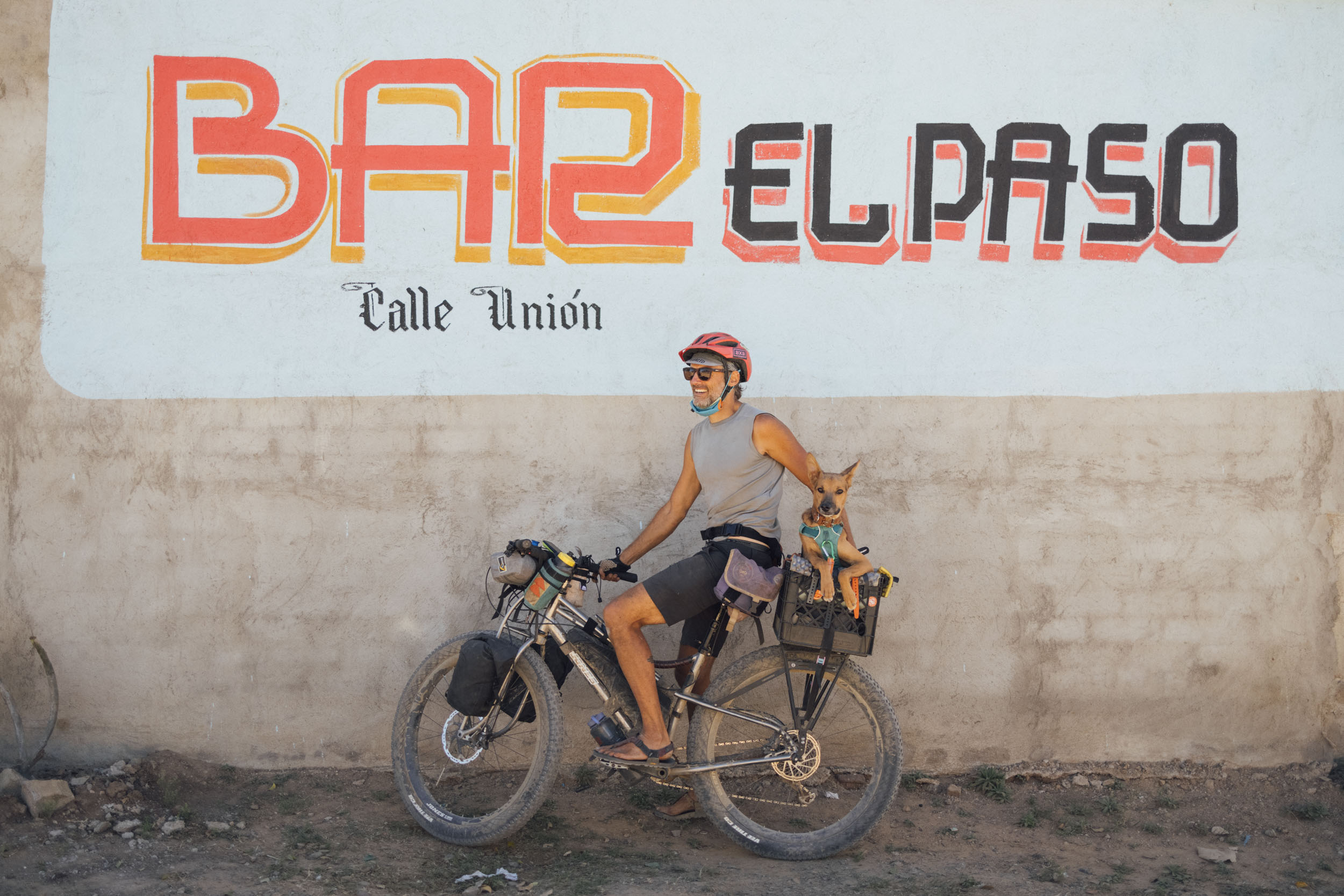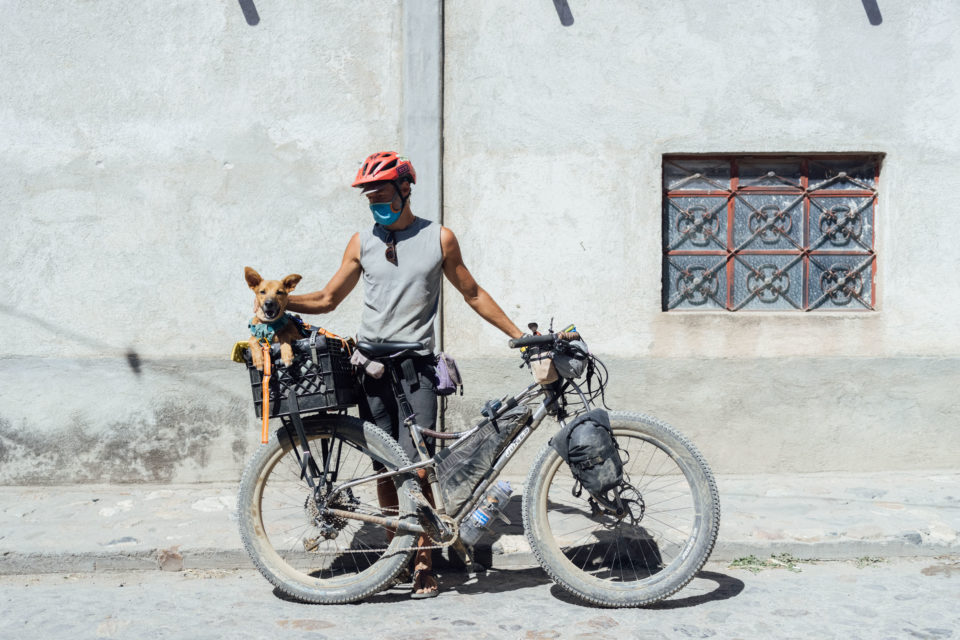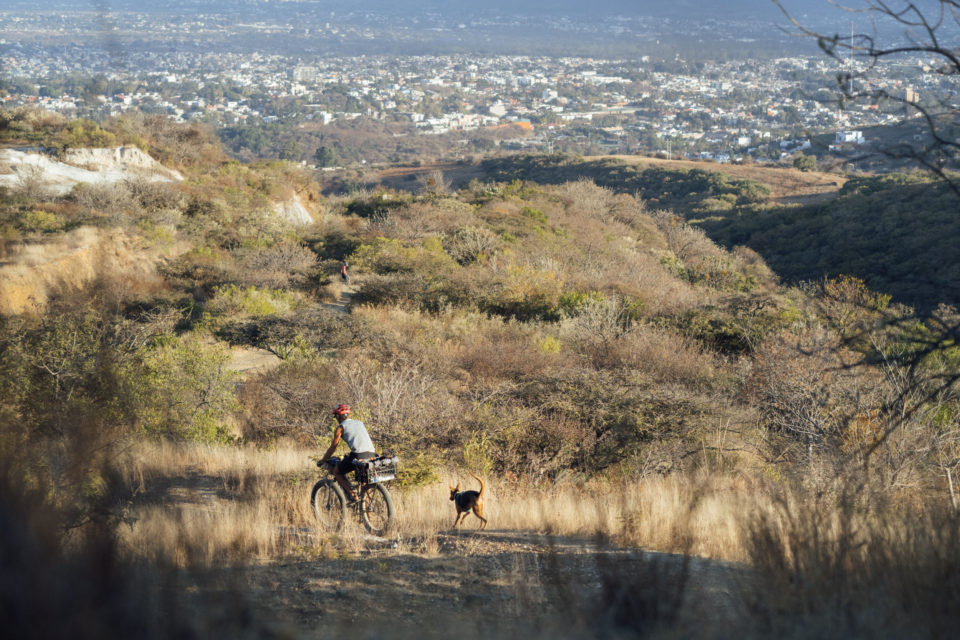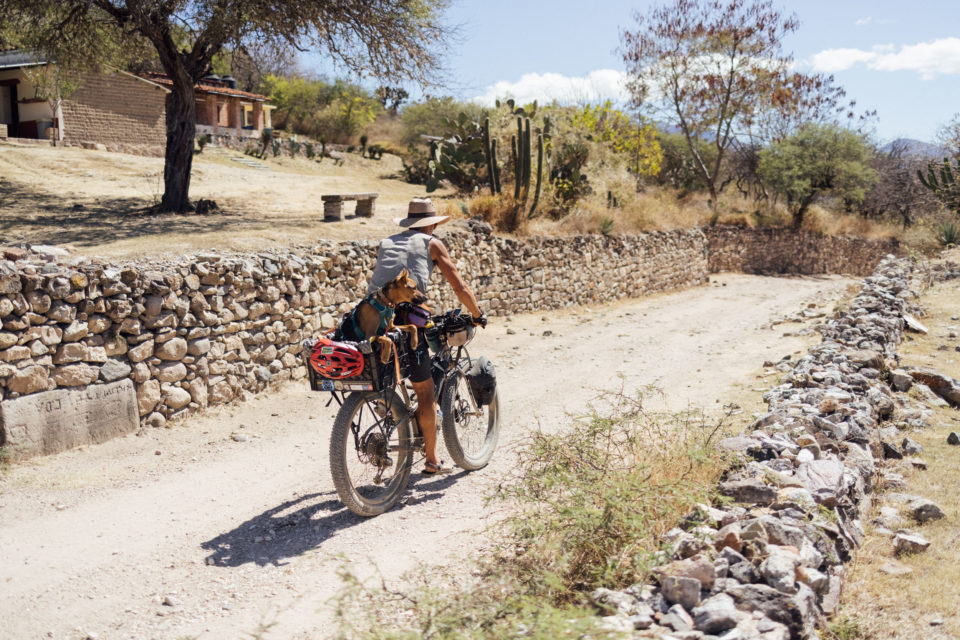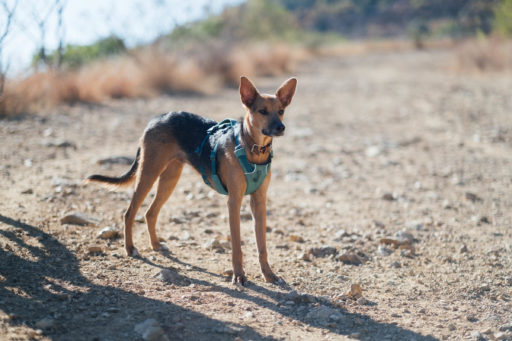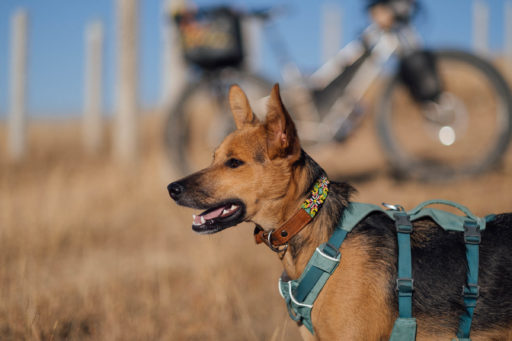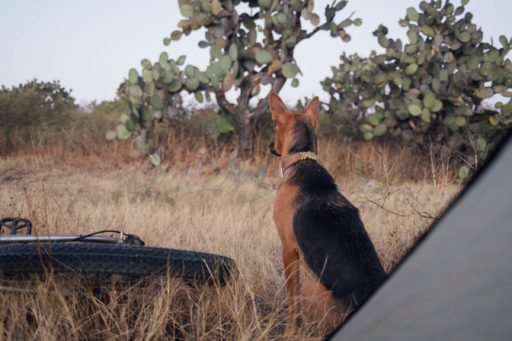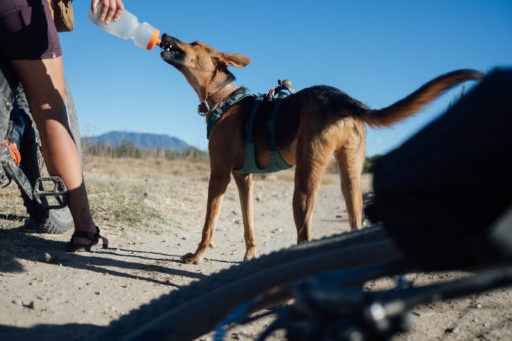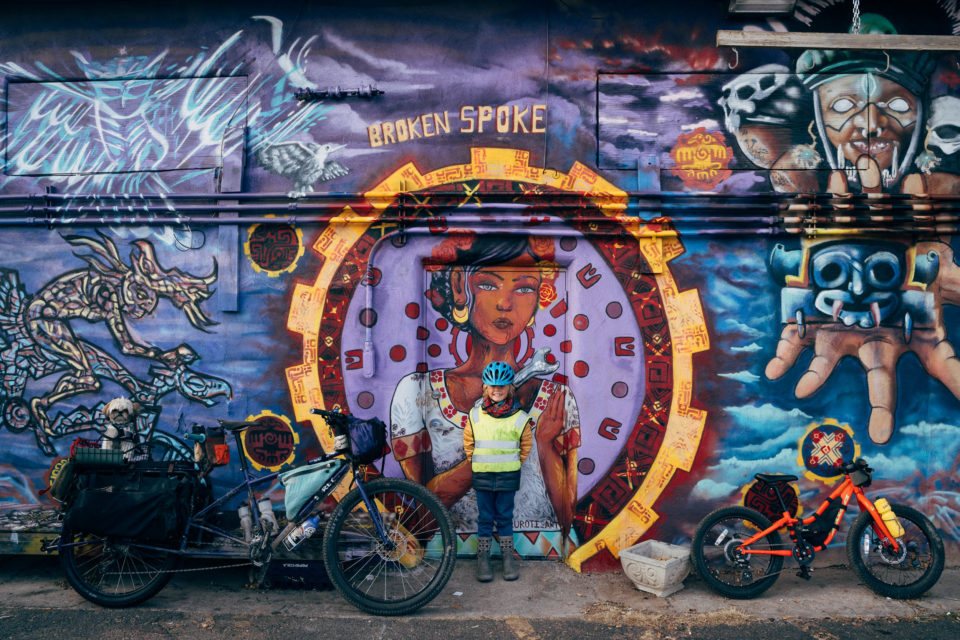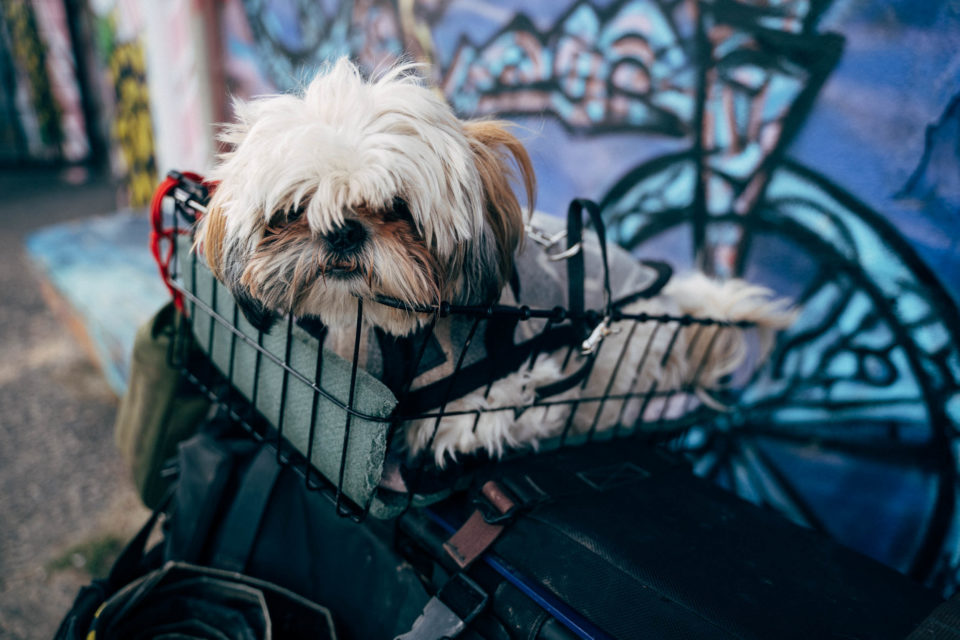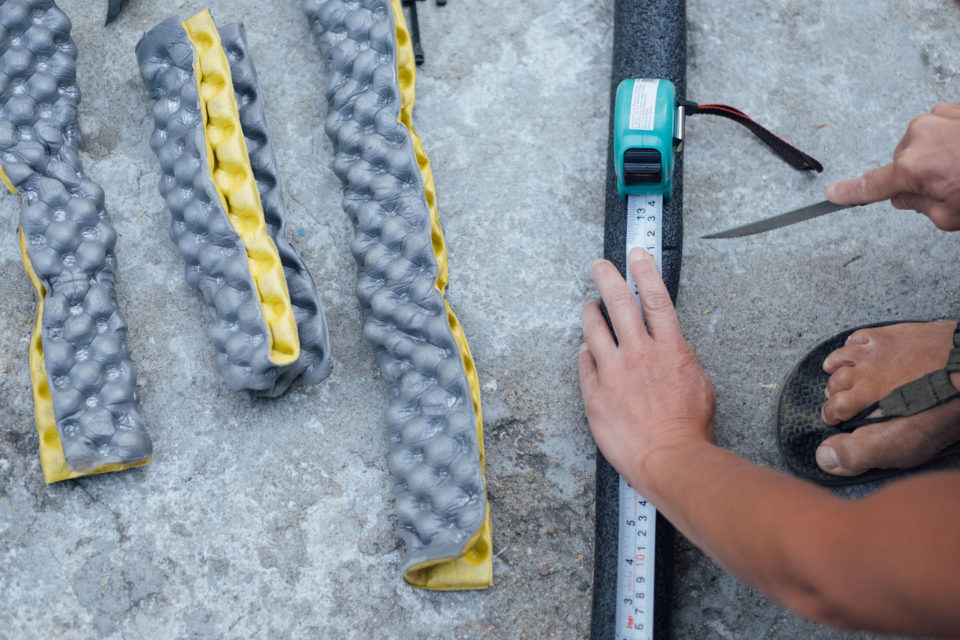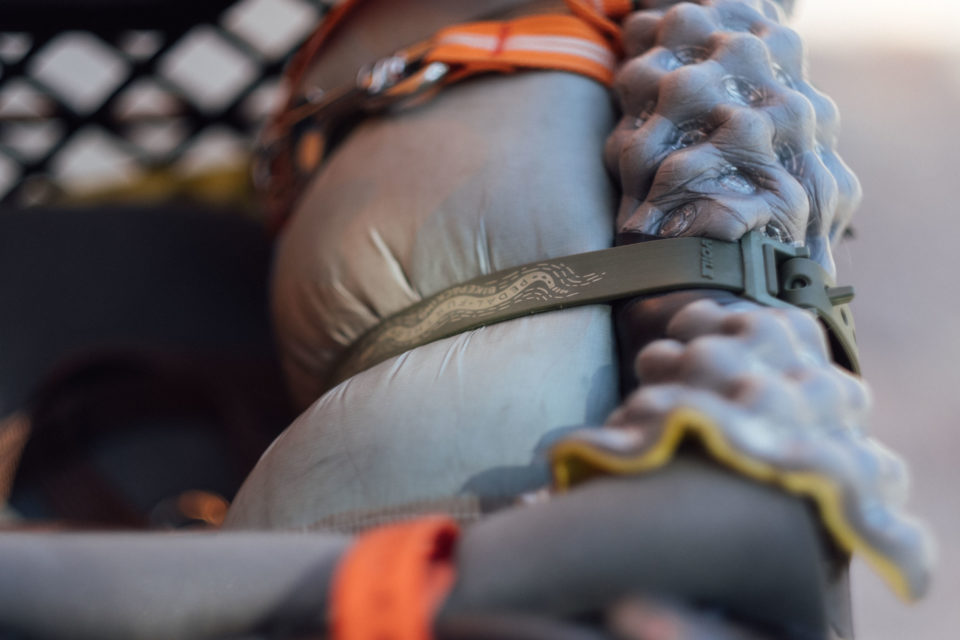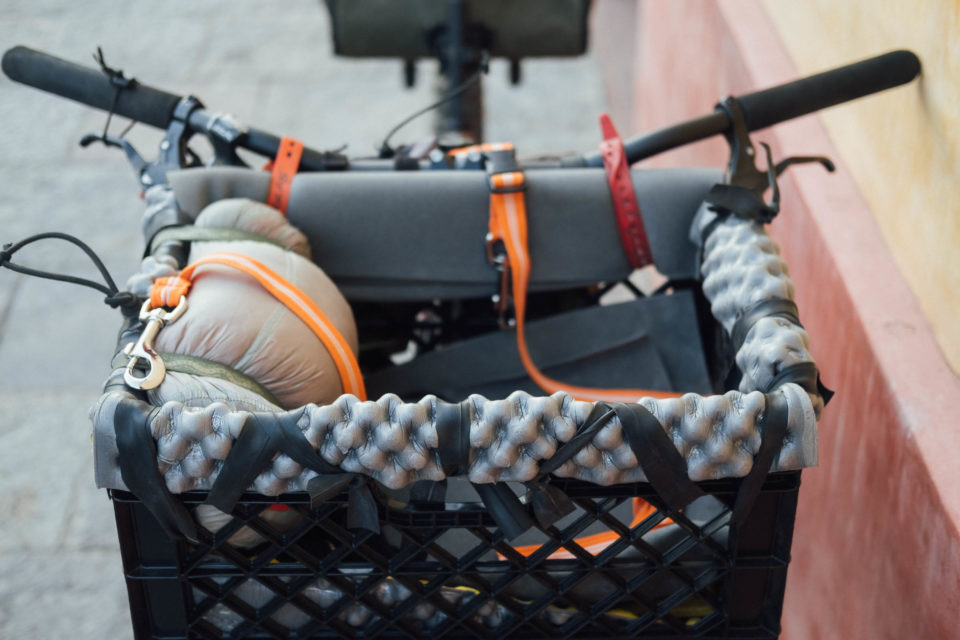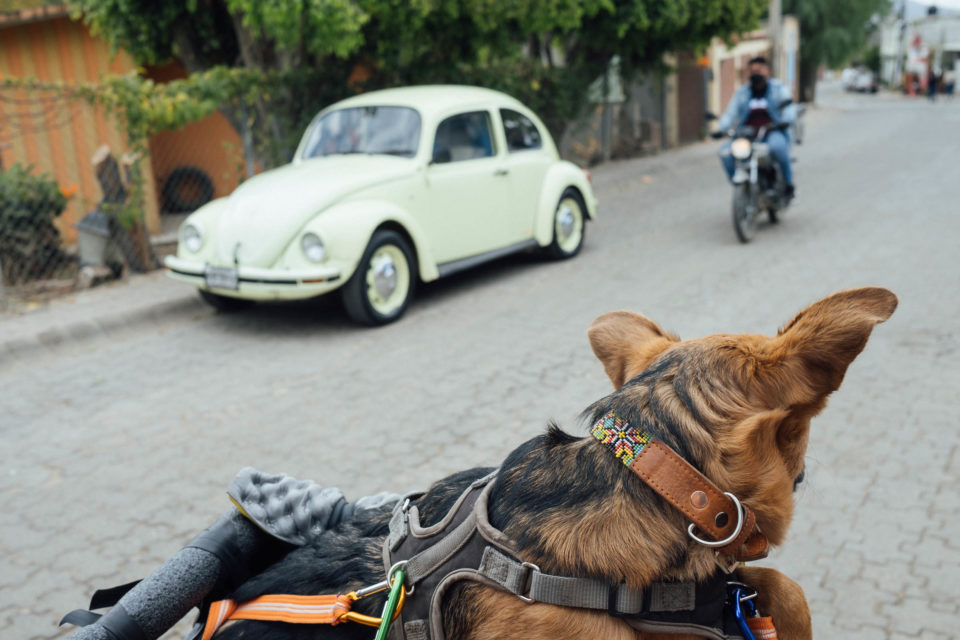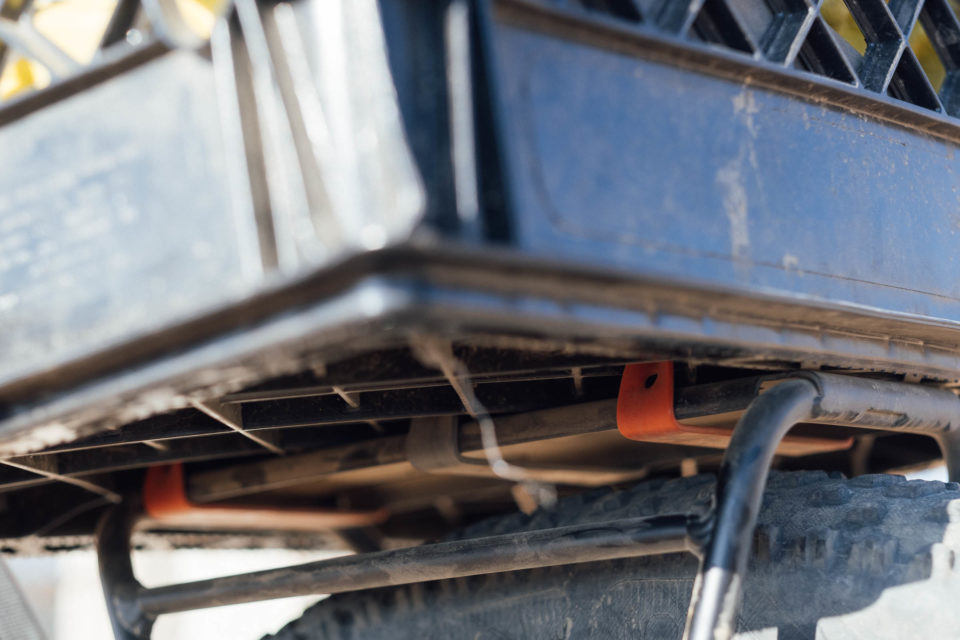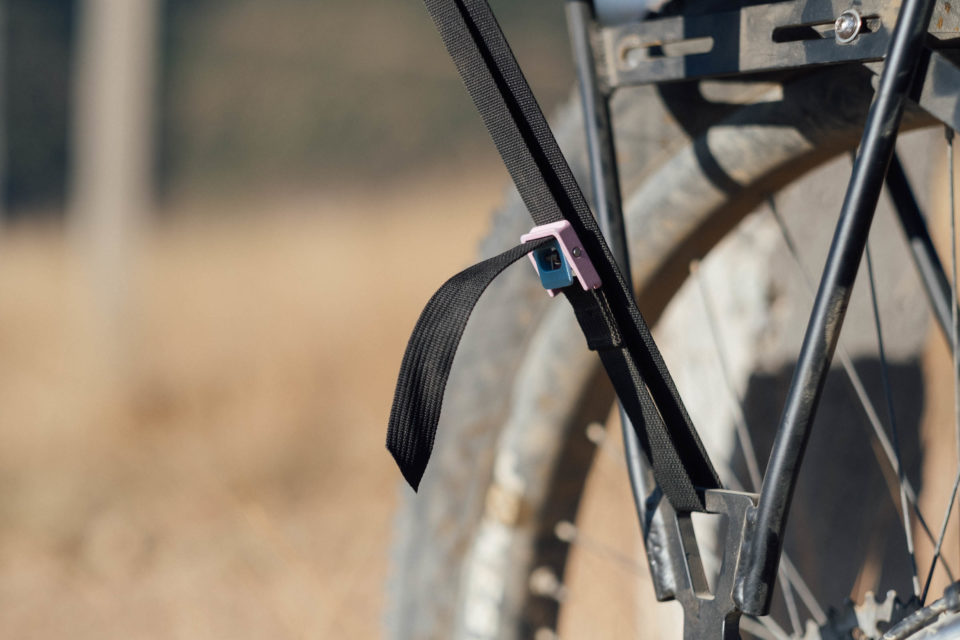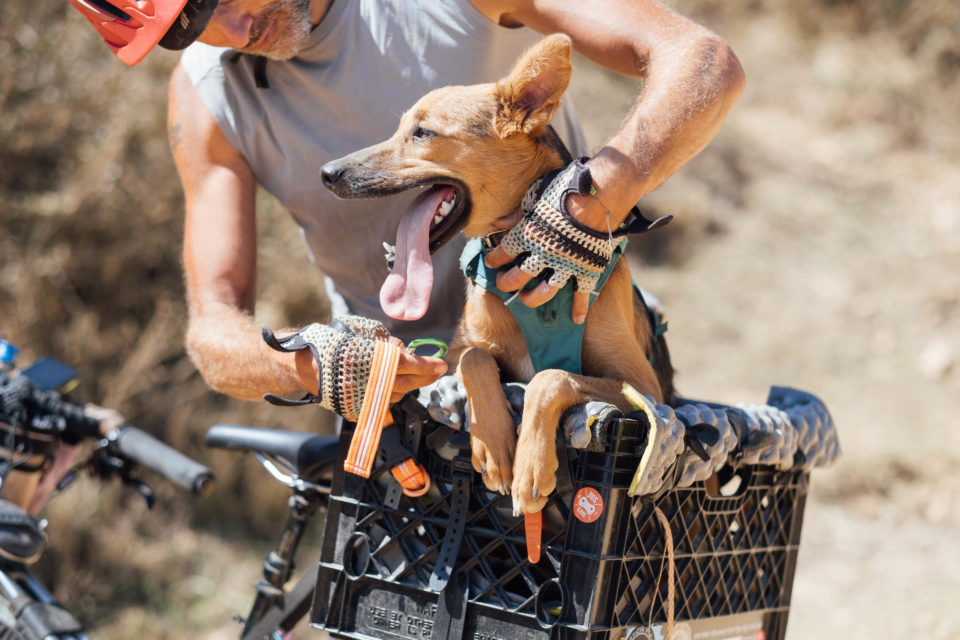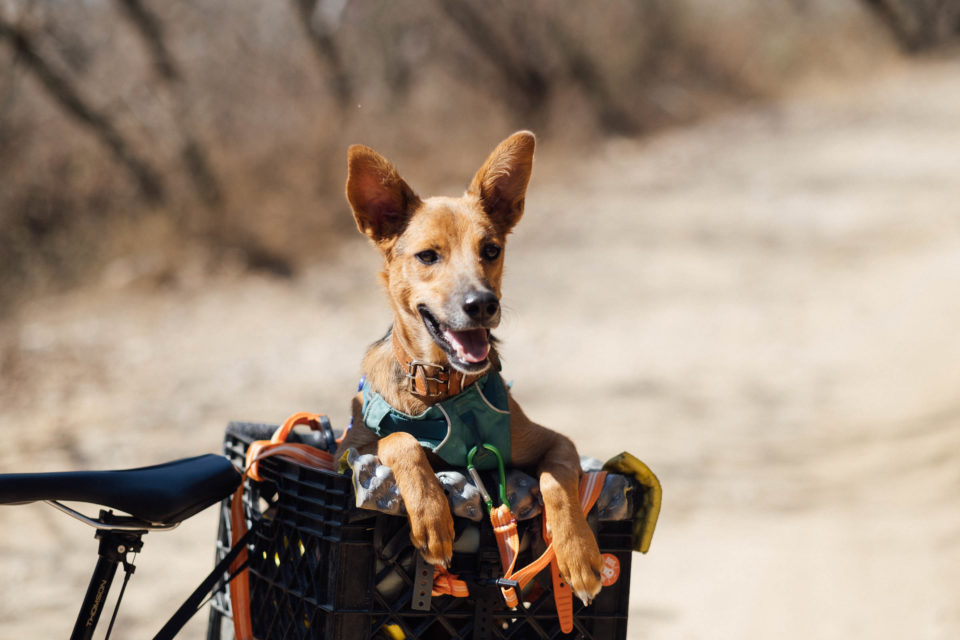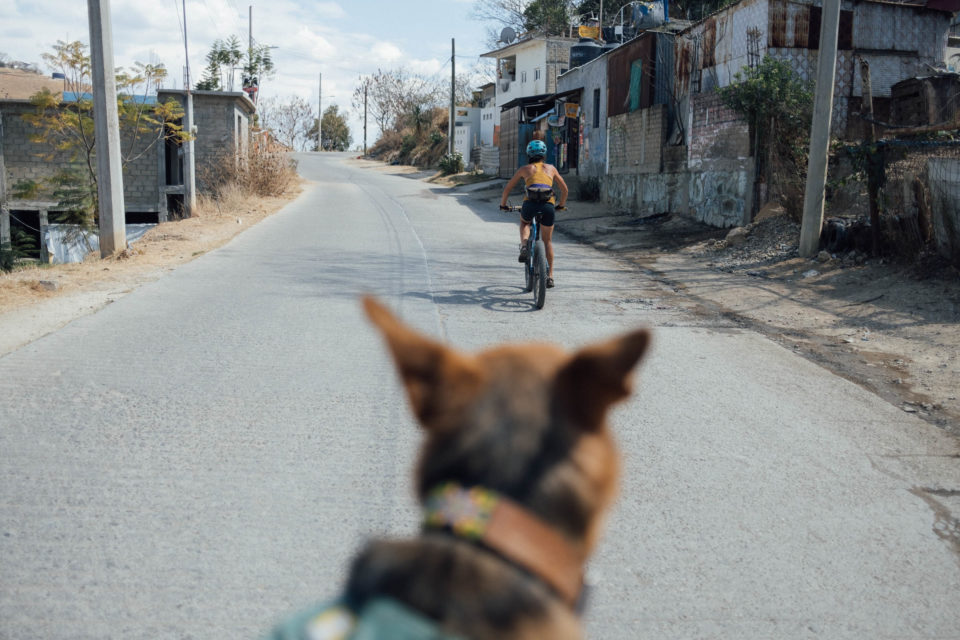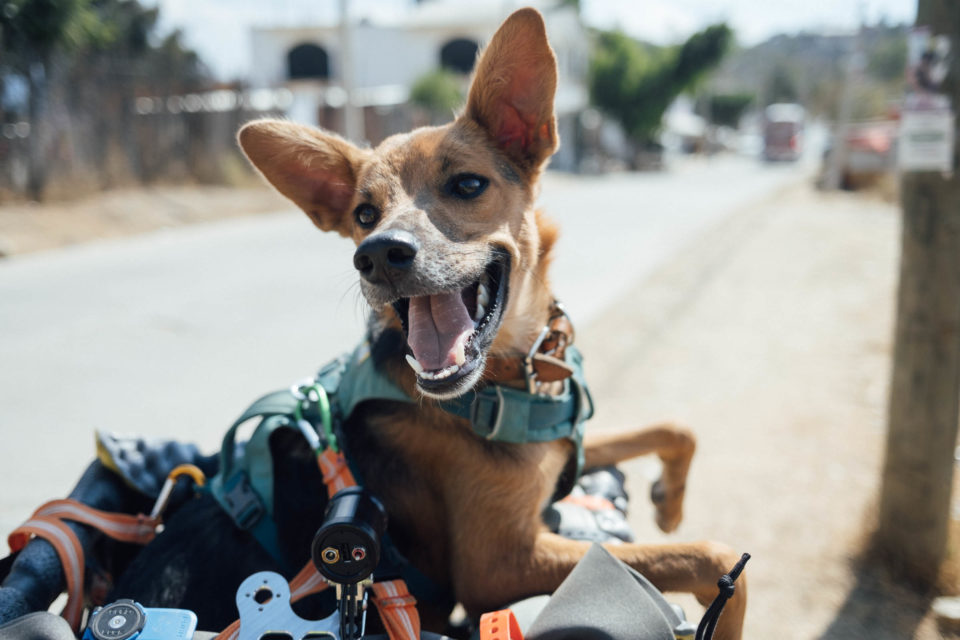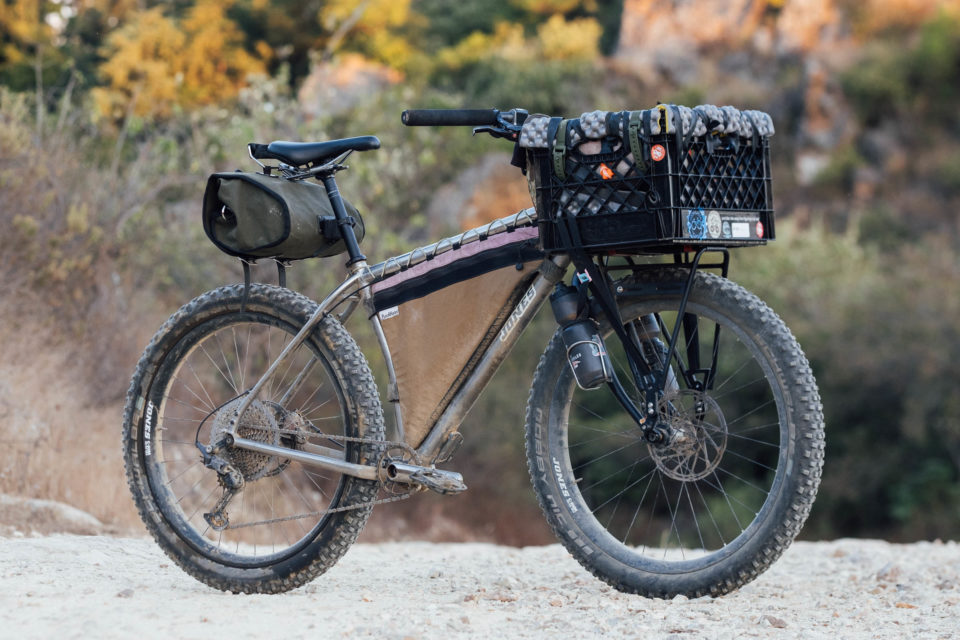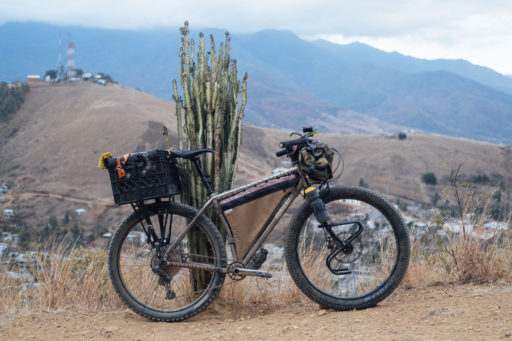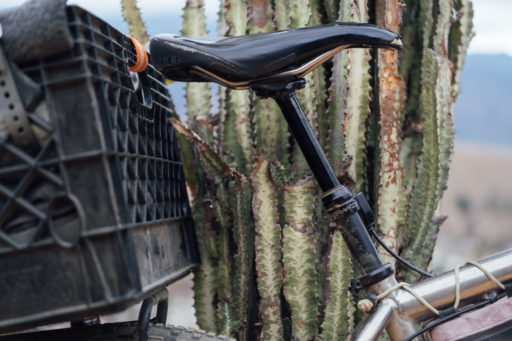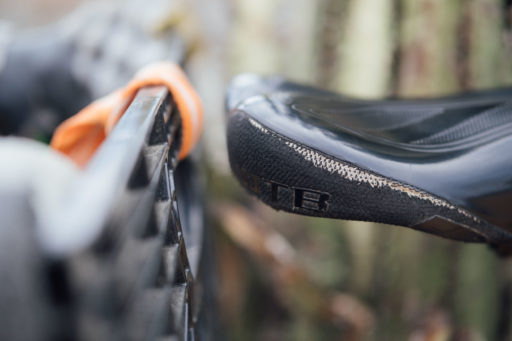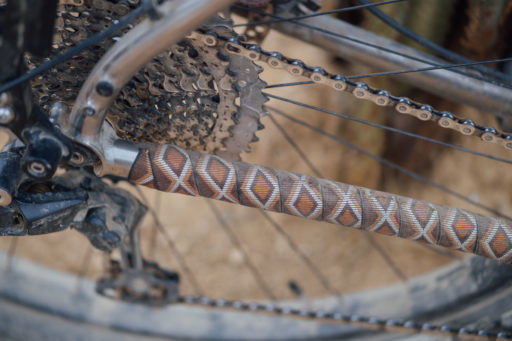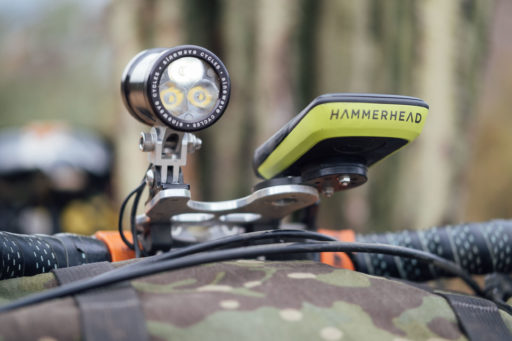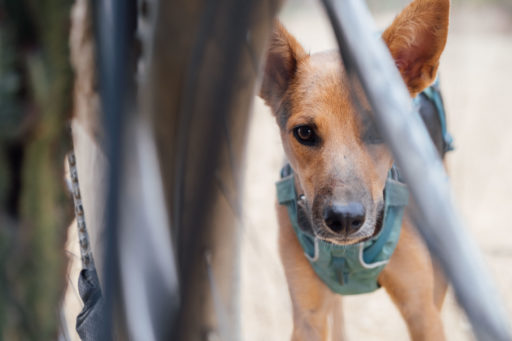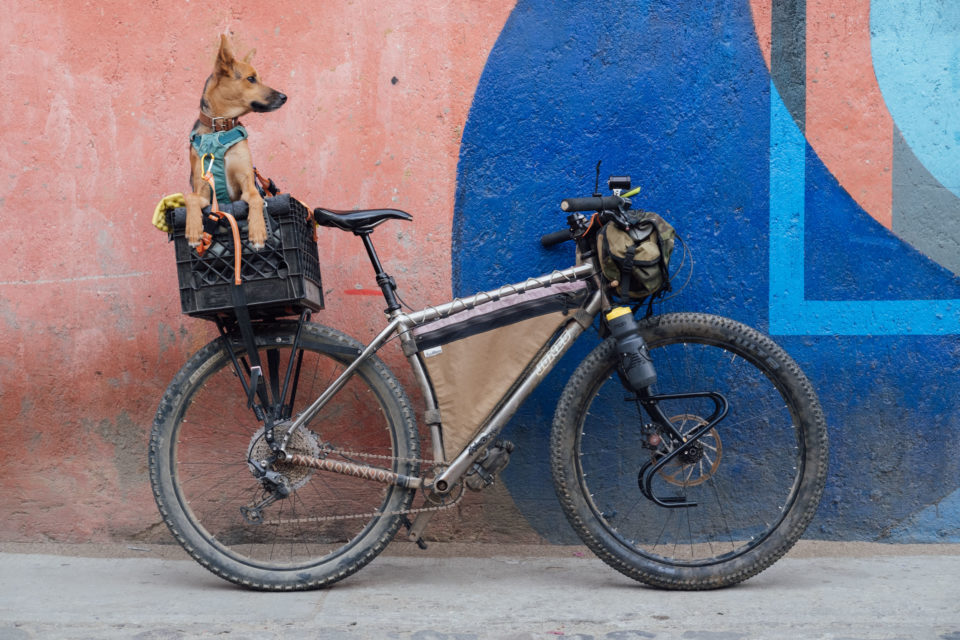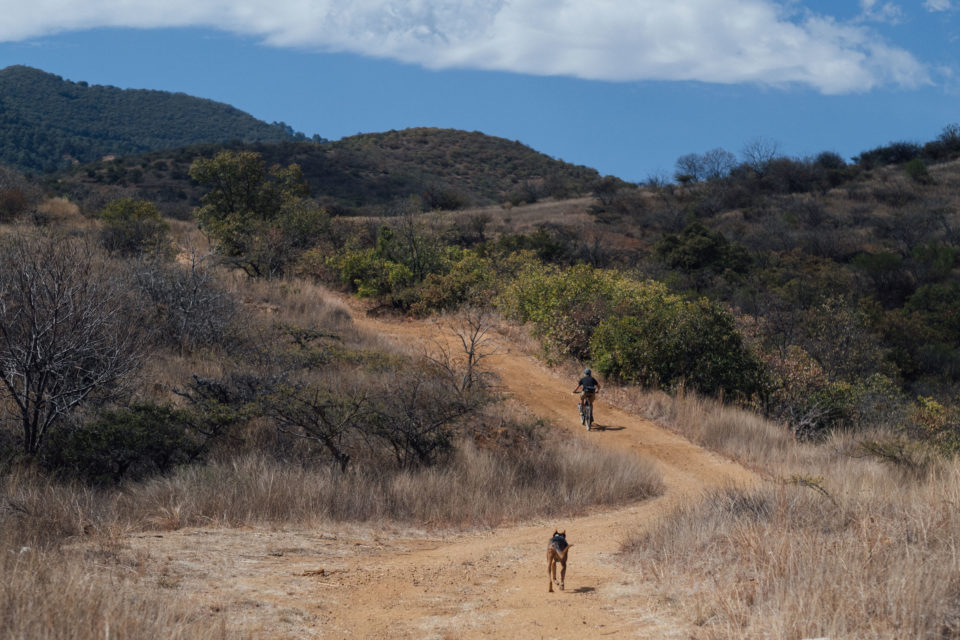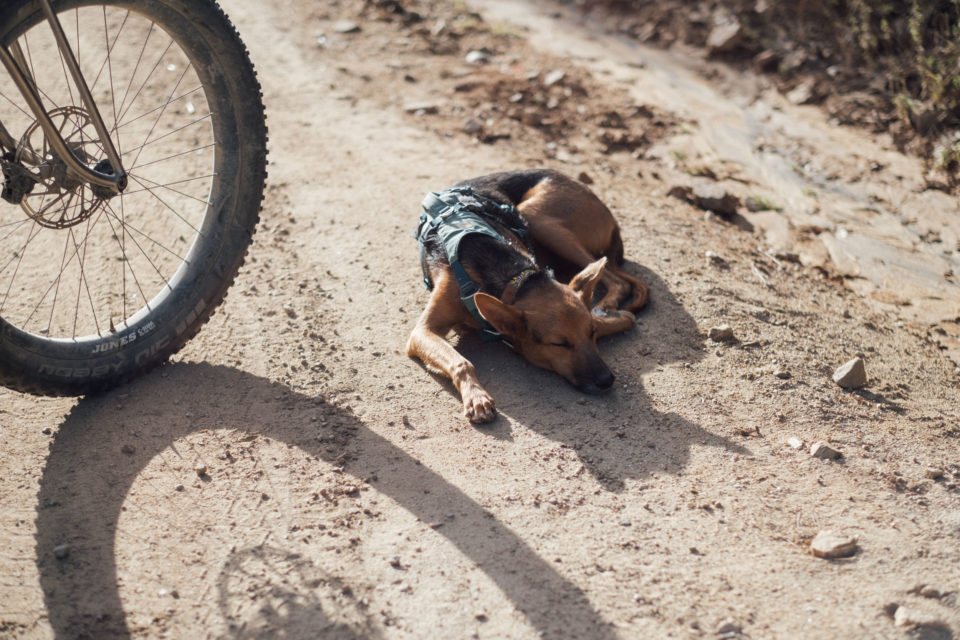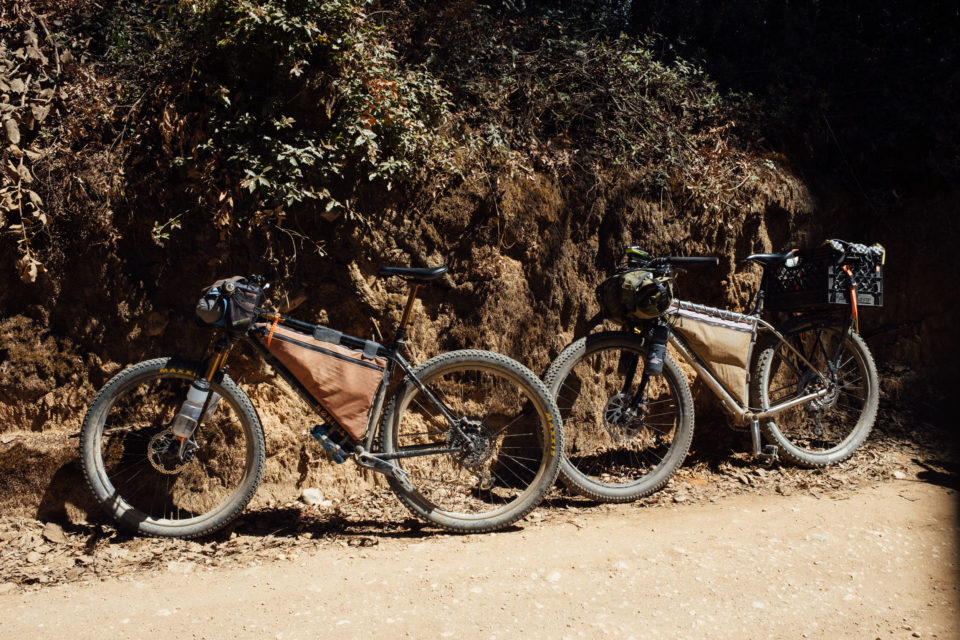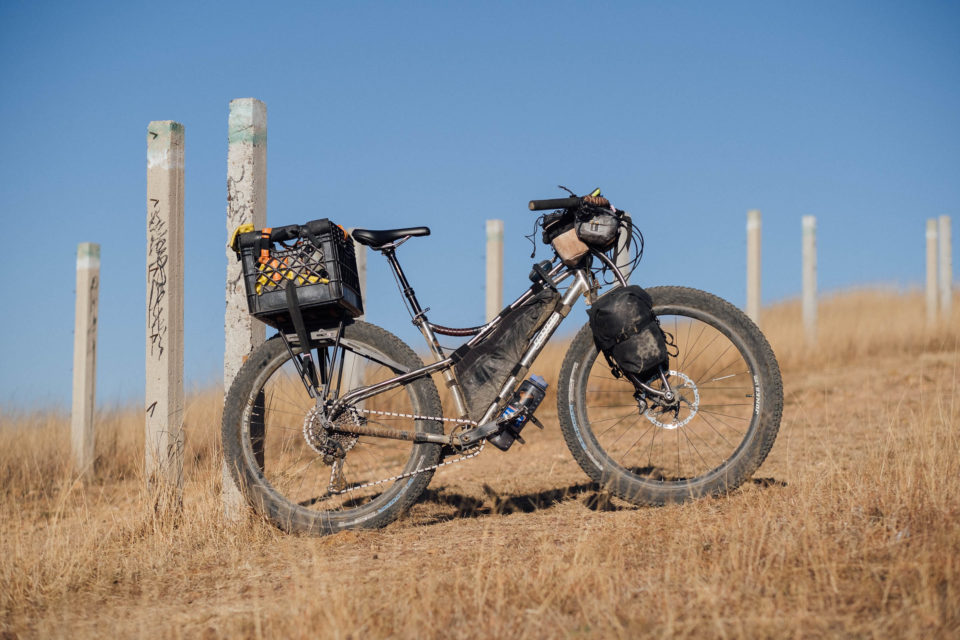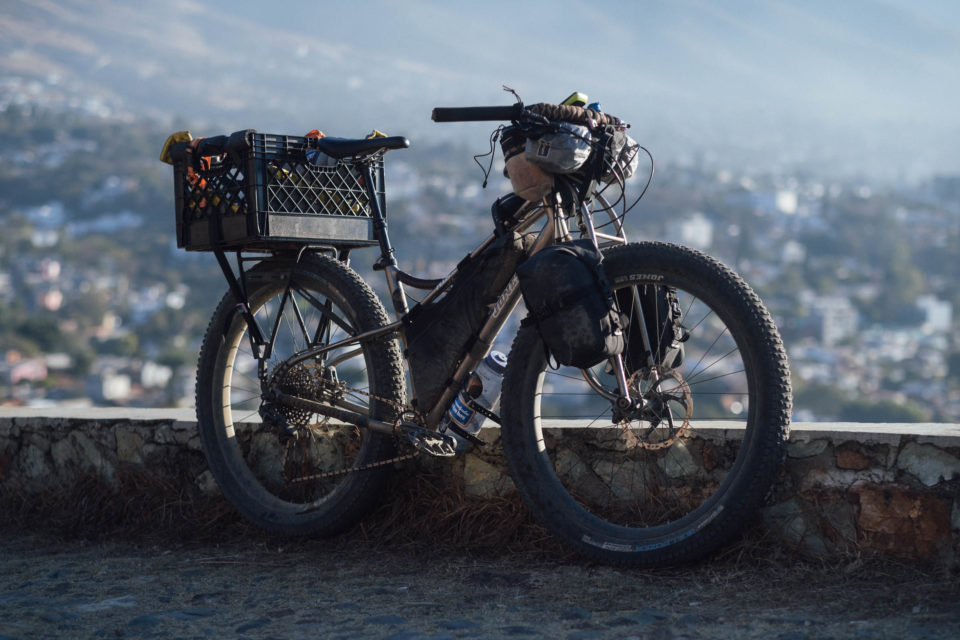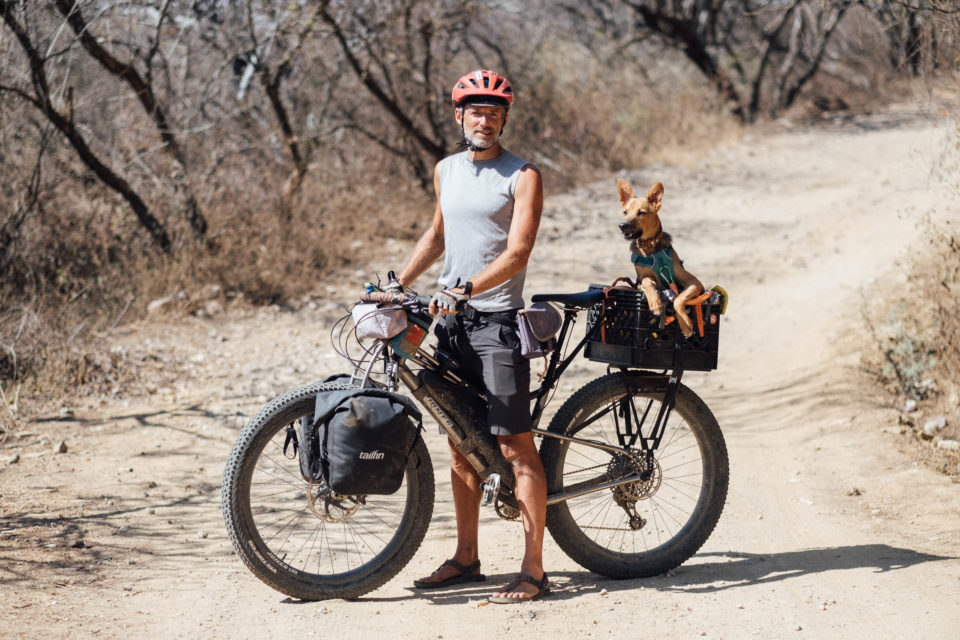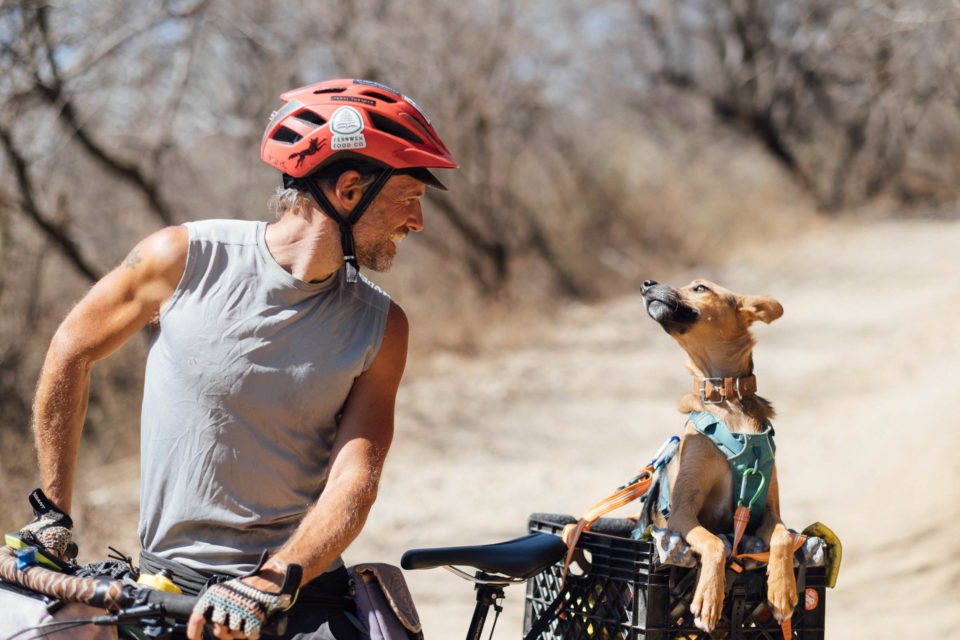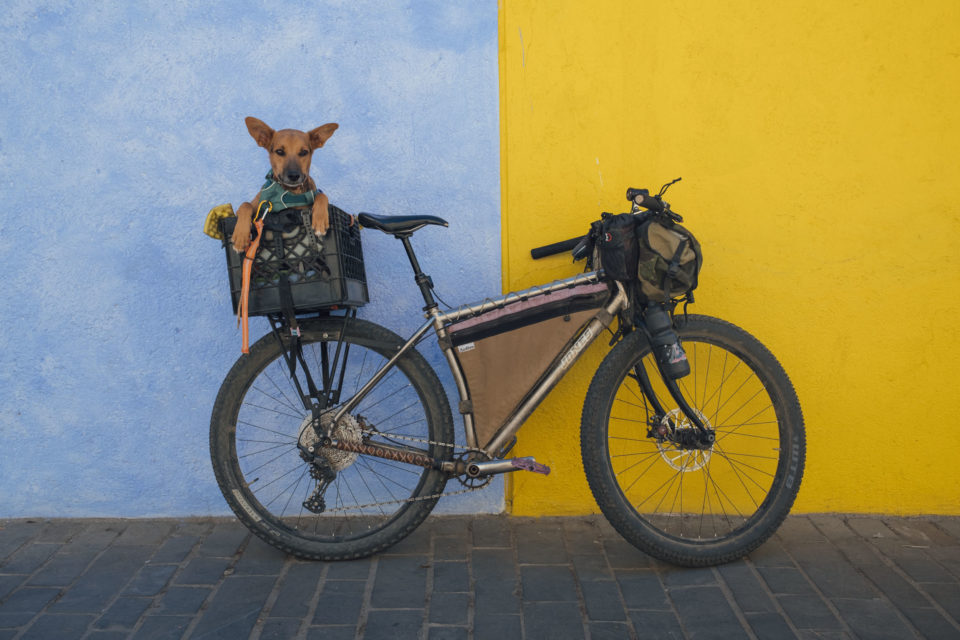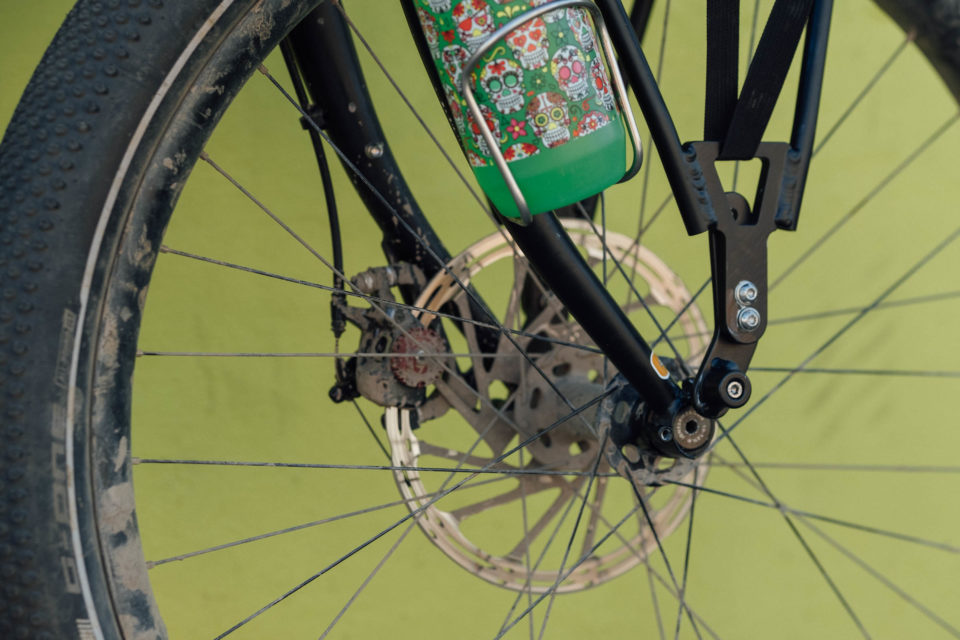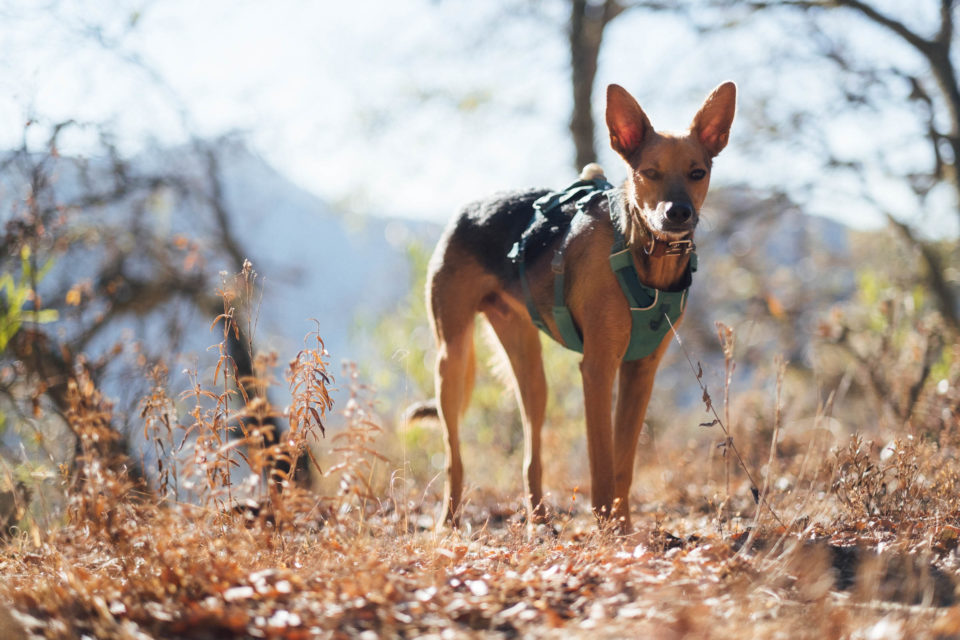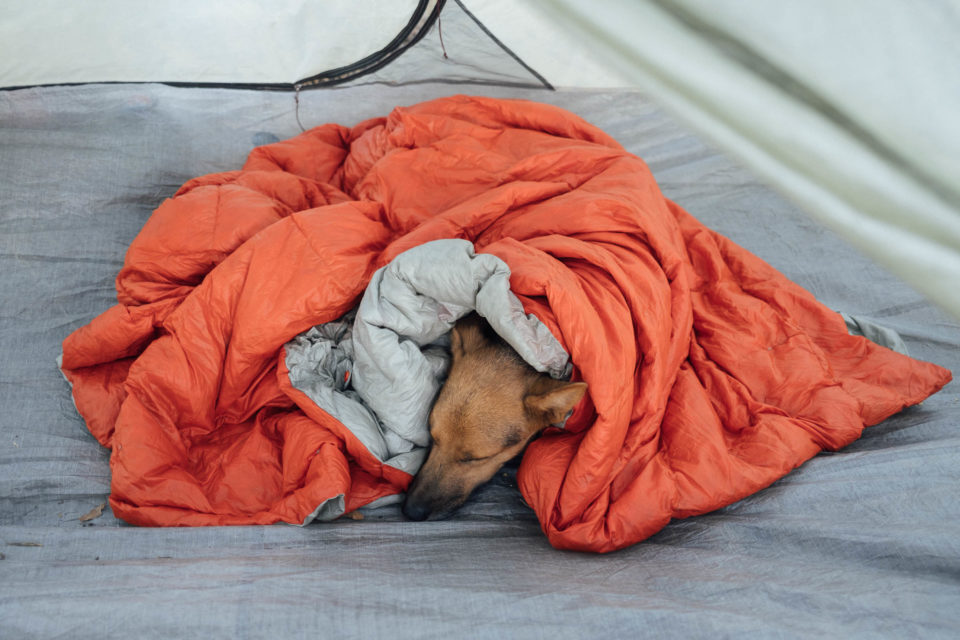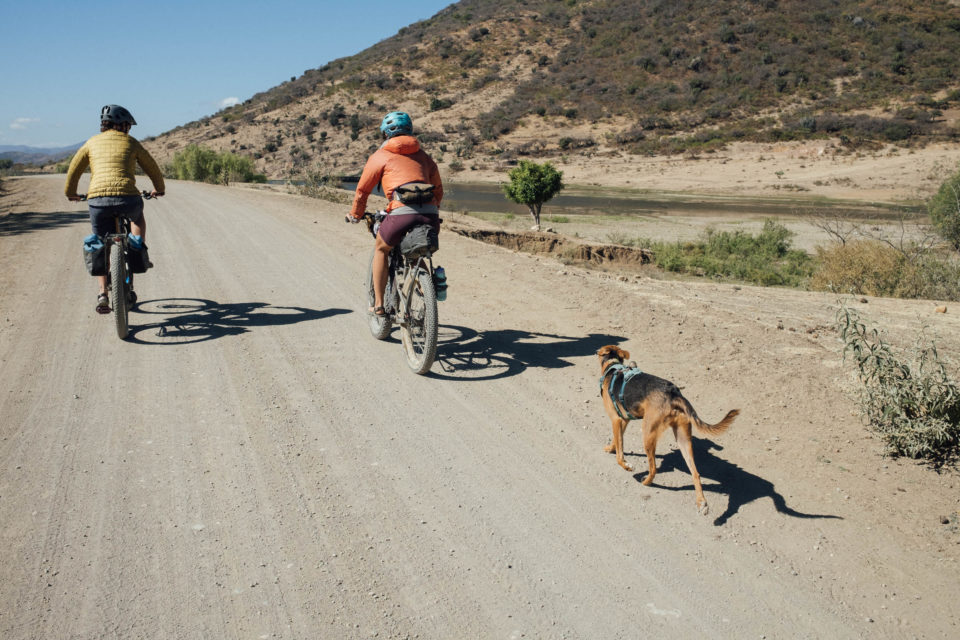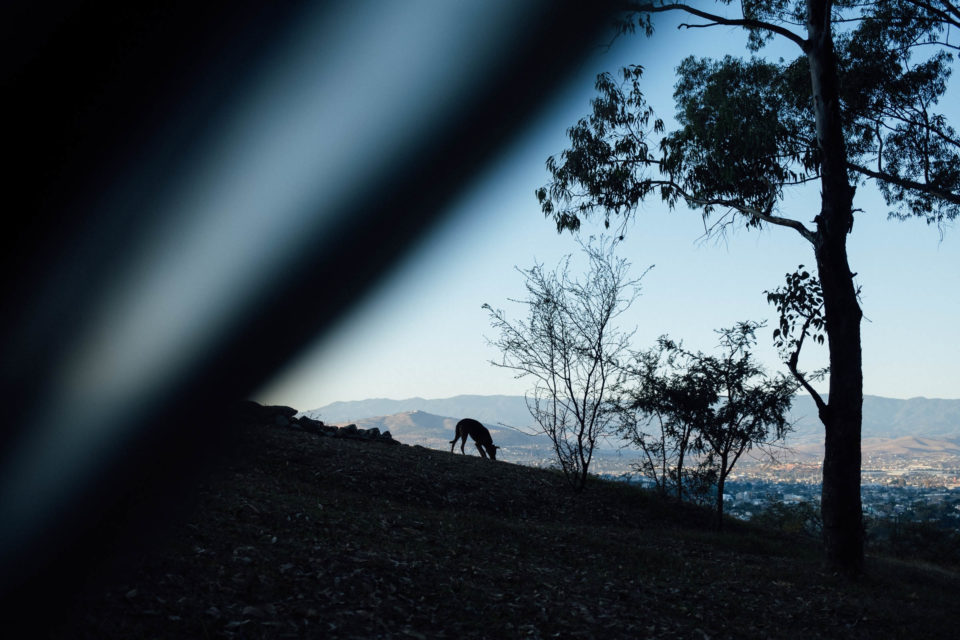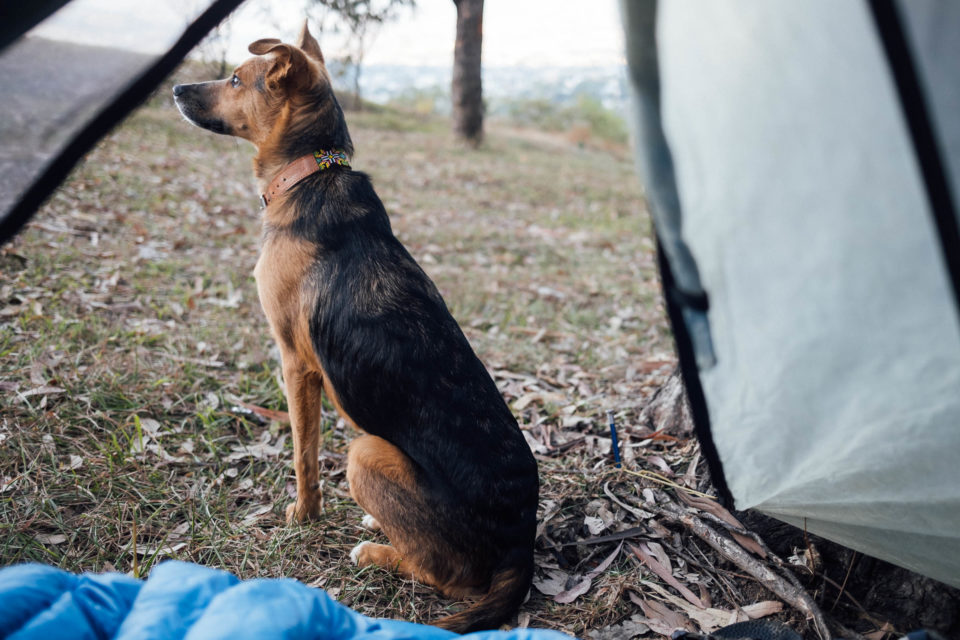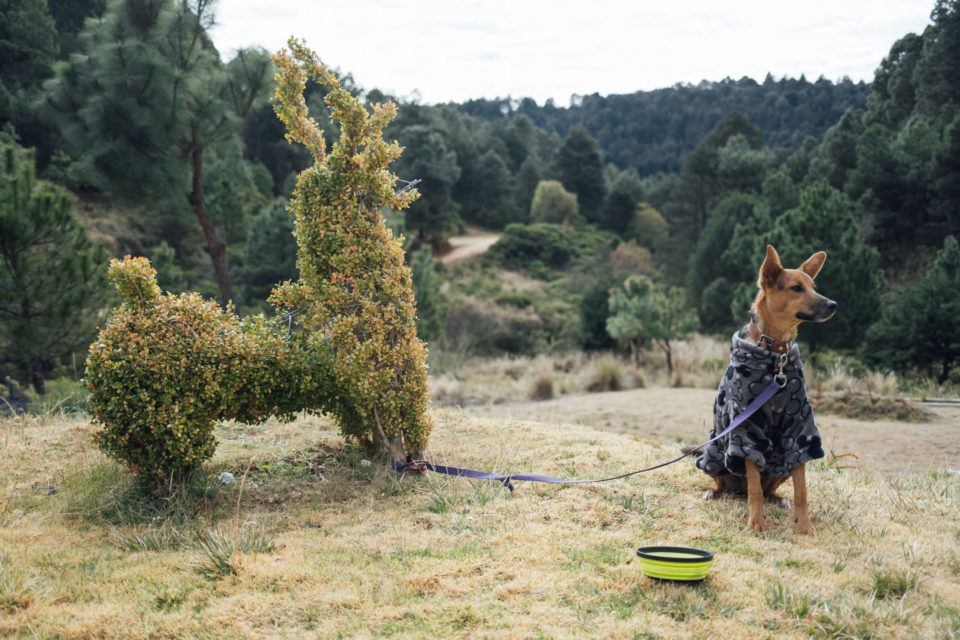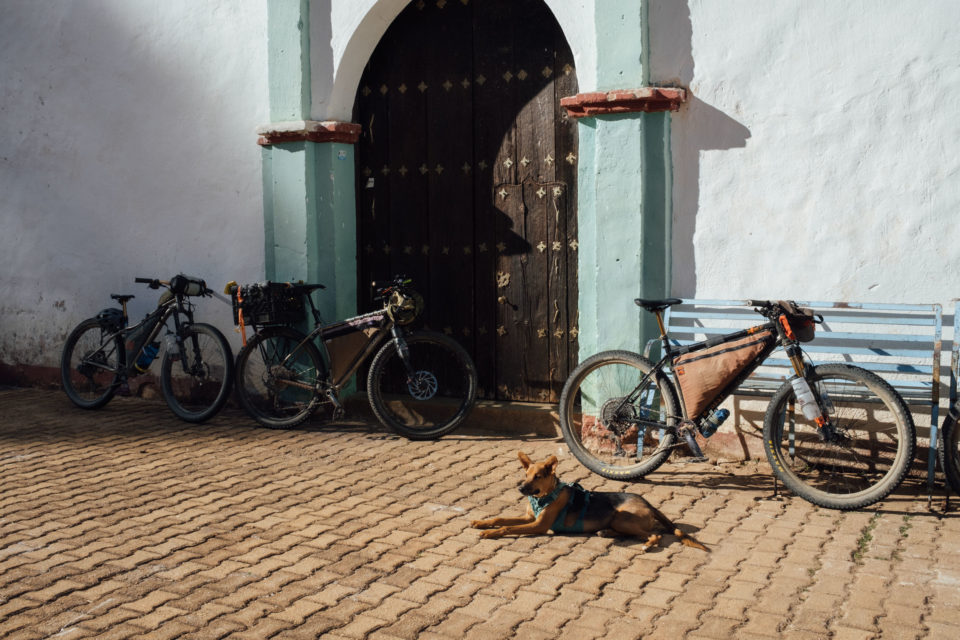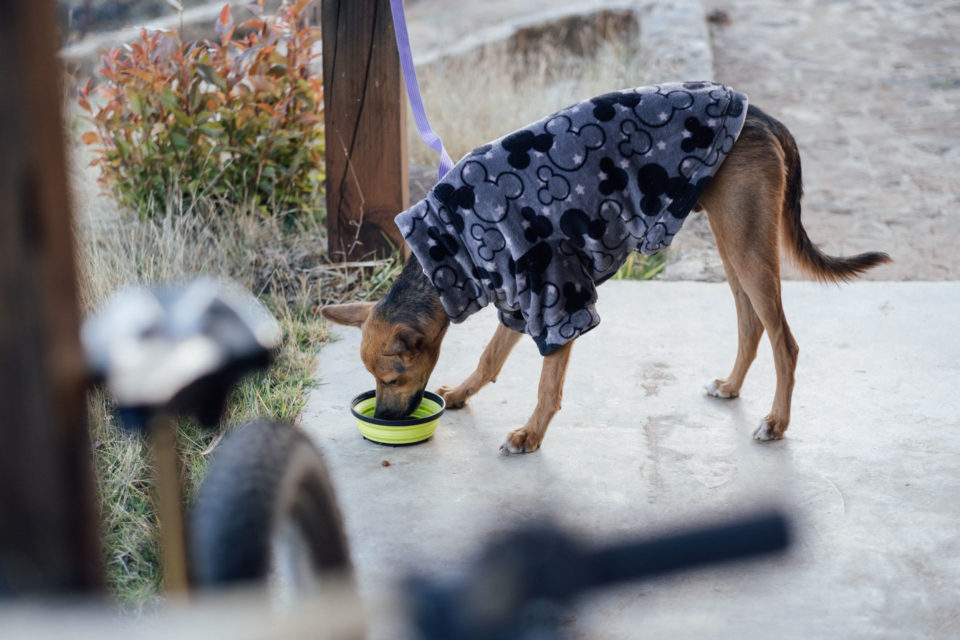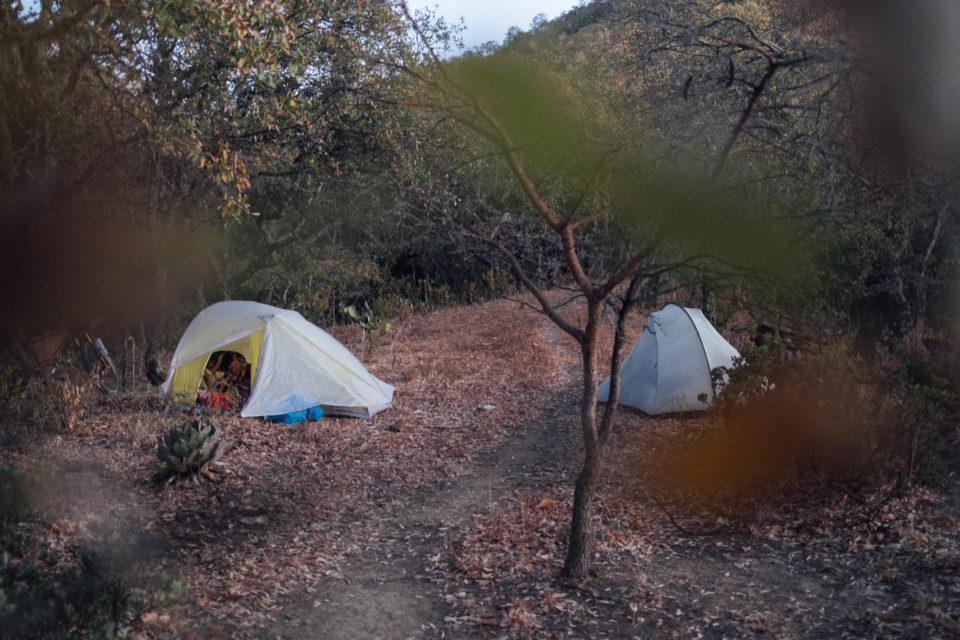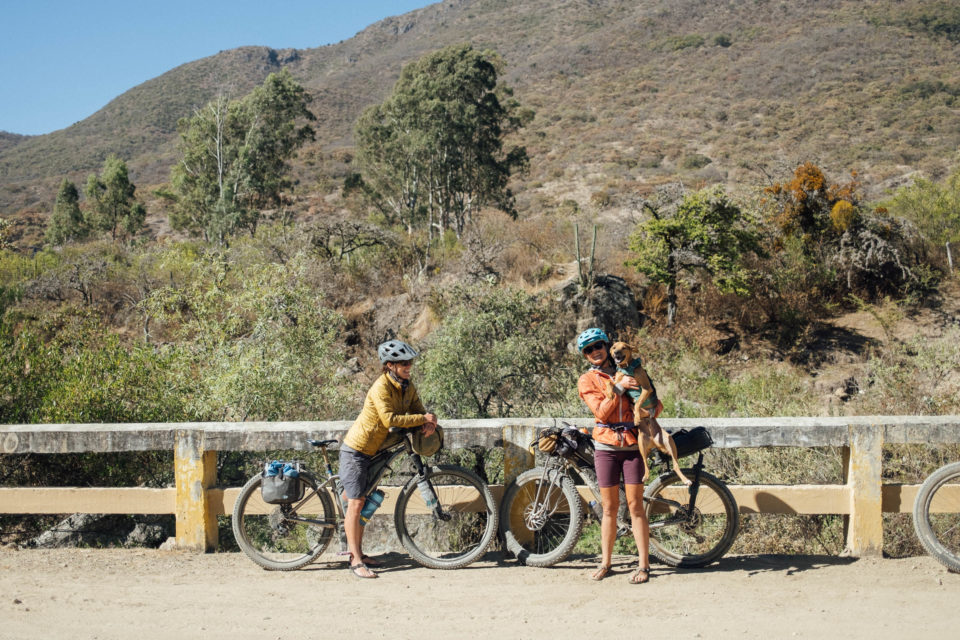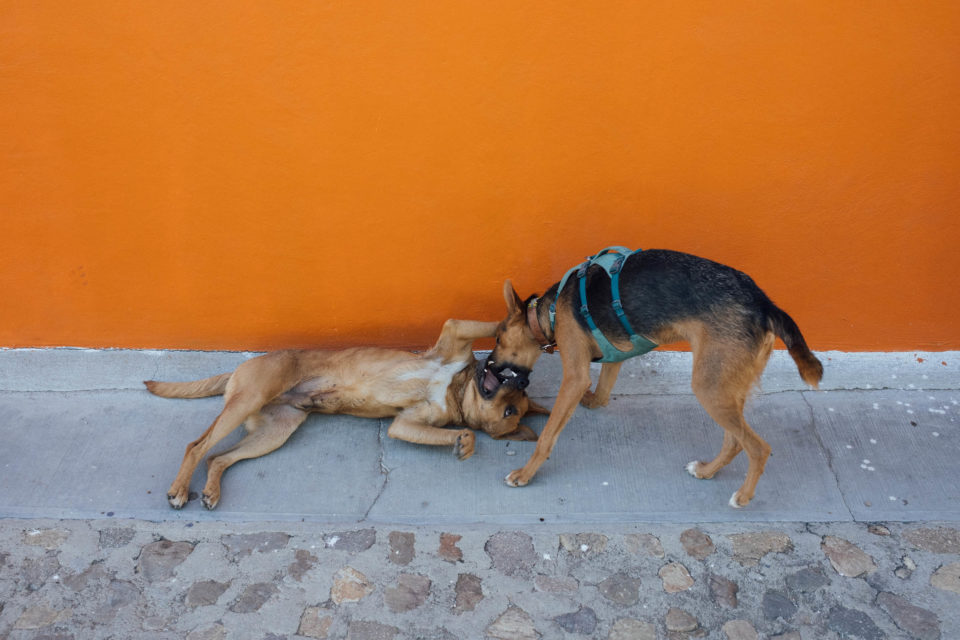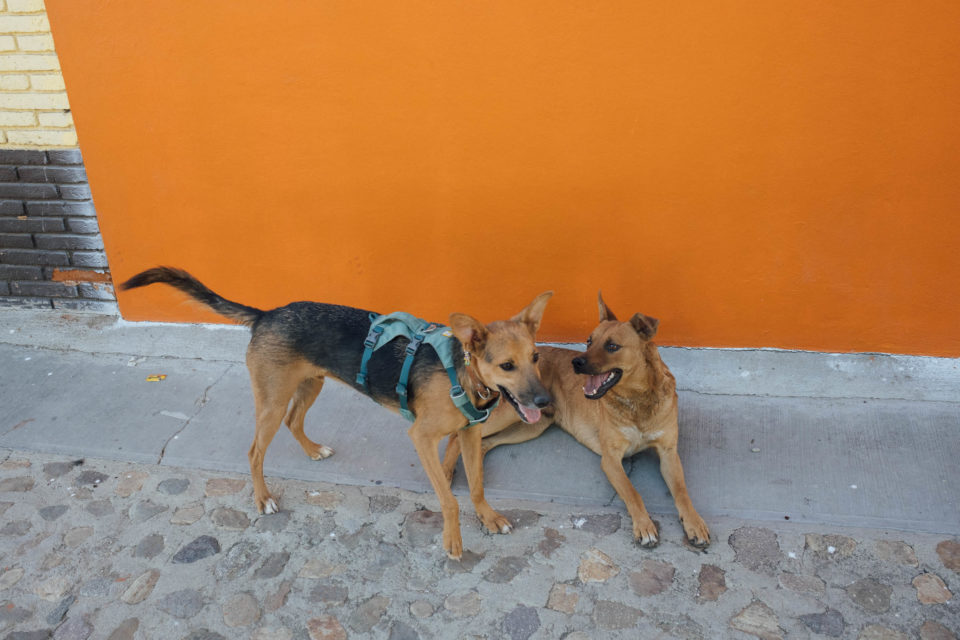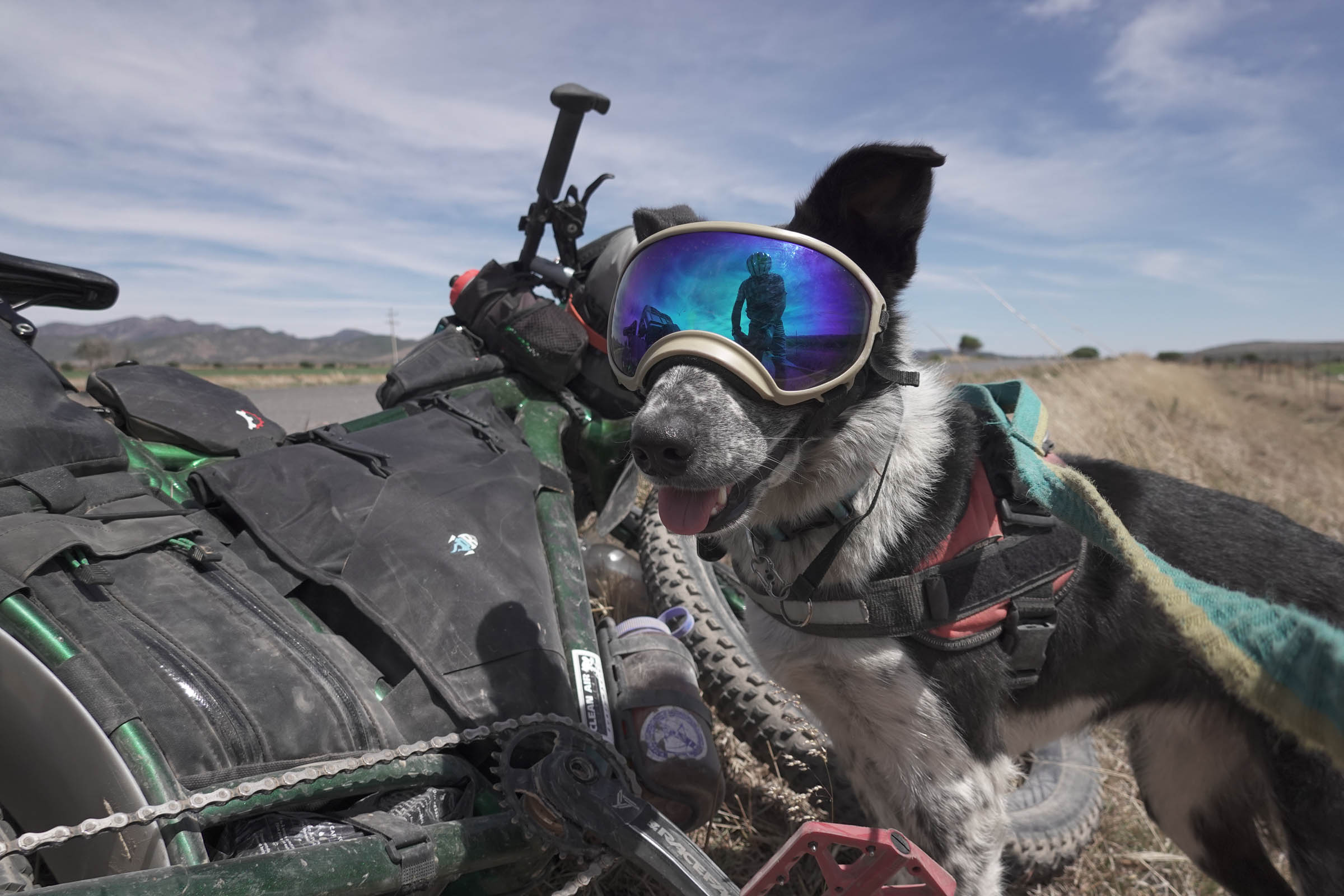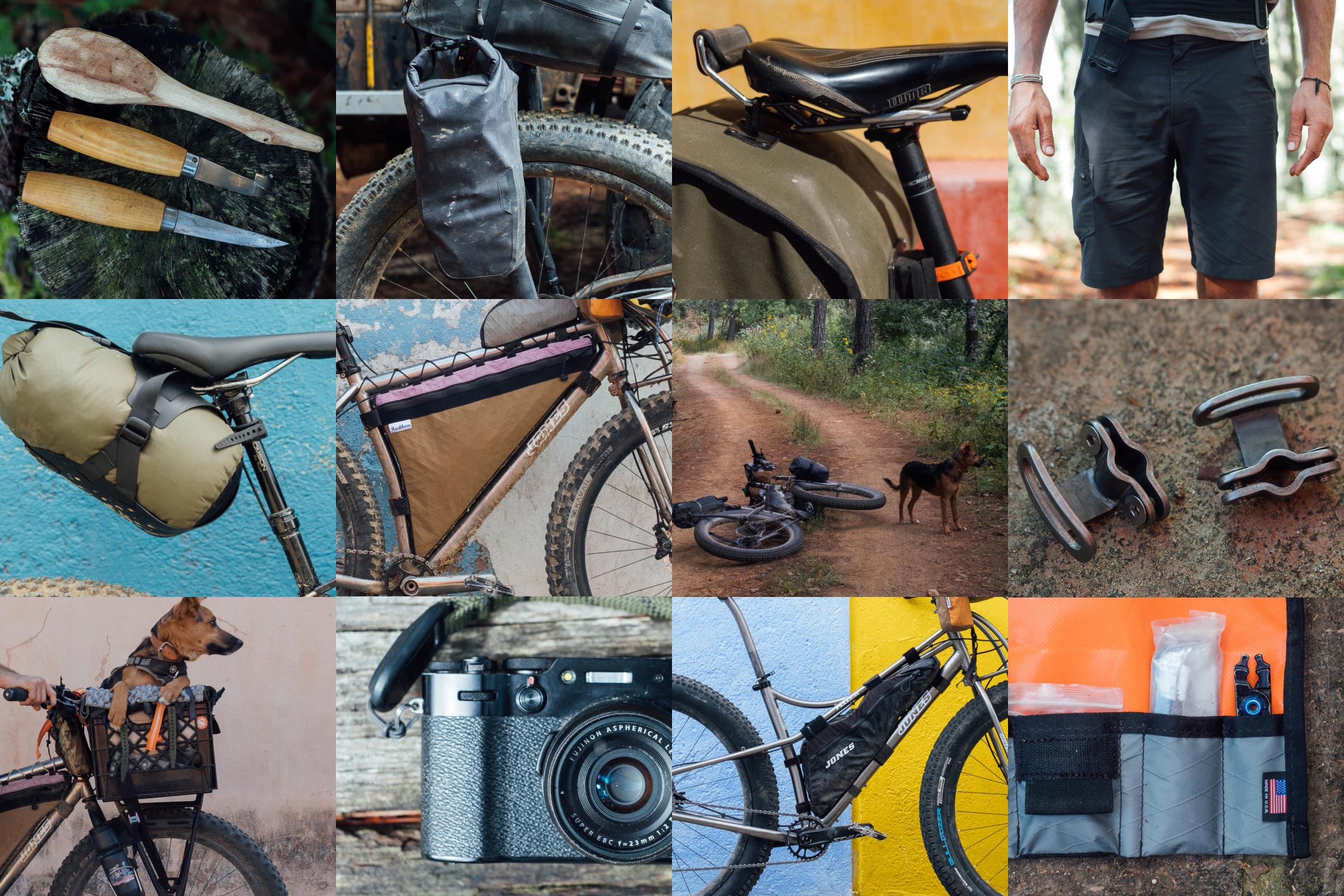Cratepacking and Dogpacking with Huesos
Share This
Newbie dogpackers Cass and Huesos share their experiences – and experiments – in cratepacking. Read on to find out all the details of their current setup and those they aspire to, along with a selection of photos from recent dirt road rambles in Oaxaca, Mexico…
With additional photos by Logan Watts and Emma Bucke
A couple of weeks ago, I shared a post detailing my experiments and experiences of a dogpacking-backpacking-bikepacking nature, if such a niche has a name. As you may have read, sweet Huesos is a once skeletal pup that Emma and I are fostering, having found him abandoned along a trail above Oaxaca de Juárez, where I currently live. After scooping him up into a handlebar bag and feeding him back to strength, we’ve been loading Huesos into a doggie backpack for day rides on my local trails and singletrack overnighters into the Sierra Norte, the imposing range that looms high over the city.
But there are plenty of times when carrying Huesos – aka Mr. Legs – in a backpack isn’t ideal, be it for trips that involve longer distances between times he can run alongside us, or those that have more dirt roads than singletrack.

As I’m learning, there is a whole slew of ways to bikepack with your furry companion. What works best for the two of you is likely to depend on a variety of factors, including the length and nature of your trips, the age, size, breed, and character of your faithful dog, as well as how much you’re prepared to invest financially in your ultimate dogpacking setup! For a great overview, you can read two excellent guides by John Freeman (and his pooch Mira), linked at the bottom of this post. They offer a tome of salient advice from a very experienced dogpacking duo.
In my case, the dog in question is Huesos. He’s a mid-sized Mexican street dog and a true callejero. On his last trip to the vet, Huesos weighed 16.6 kilograms (36.5 pounds). He’s long-limbed and fast out of the blocks, but as educated guesses put him at just 11 months old, it’s important not to overrun him. My dogpacking aspirations? To bring in him along on short dirt road adventures here in Mexico – from a night to a week – rather than multi-month epics. As most of the roads I ride are relatively rough, my setup needs to be comfortable and capable across a variety of terrain, for both of us.
As mentioned, Huesos was abandoned as a young pup, and his emaciated build befitted the name we gave him: Bones. I expect the first couple of months of his life were devoid of much in the way of nutrition, except for the rhino beetles he crunched on. His leg bore a puncture wound from a dog bite, in which maggots festered. He was anxious, hated to be picked up, and was terrified of other dogs, large or small. A lot has changed for Huesos since then and he’s certainly been living his best life. Now that he’s been showered with endless love and tacos, he’s becoming more confident by the day, with a manner and smile that melts the hearts of strangers. He’s so happy that he even wags his tail in his sleep!
As for me, I have just a little experience carrying dogs on bikes. When I was younger, I pulled our family’s German Shepherd in a trailer to the beach, and back in the US, I’m the proud owner of a Surly Big Fat Dummy – my pedal-powered F150 – which I use to carry my son, his bike, and his little Ewok Shih Tzu on local outings. But before Huesos, I’d never been dogpacking.

So, how best to carry this callejero on multi-day trips? Pondering setups is as much my profession as it is my pastime, so it was inevitable that my head was quickly swirling with ideas. My Big Fat Dummy pickup truck would be, without a doubt, a fantastic option. But its sheer size is also its downfall. I’ve yet to figure out a way of transporting it down to Mexico and I doubt it would fit on any buses even if I got it here. For now, it’s sidelined to New Mexico, loaned out to a friend in Las Cruces where it’s being put to good use on family rides and desert campouts. Instead, my mind gravitated towards more compact midtails – Salsa’s now discontinued Blackborow would likely be the perfect candidate, being shorter and lighter than the BFD, yet almost as capable. Or, perhaps Huesos would be best conveyed in a more cargo-specific steed still, like Omnium’s Mini-Max Wifi? The latest version sees the addition of thru-axles and increased tyre clearances over previous models. Although less proficient off-road, the latter’s 20-inch wheel could well be handy for a couple of good reasons. For one, the bike handles more predictably, whatever the cargo it’s hauling, whilst the height of its platform means it would be easier for my furry payload to hop into and out of too.
And then there’s the question of trailers – Frances’ Cycles Farfarer and Tout Terrain’s Mule look especially appealing for off-road travel and you can check out our trailer guide for other ideas. Or, for the most dedicated of dogpackers, there’s even the custom route – I have a like-minded friend new to framebuilding that I’d love to build me a dogpacking rig tailored to my needs.
But, the reality is that all these options involve either significant logistical challenges or some serious financial investment. This means that for now, Huesos’ dogpacking journey is unfolding around the two bikes I already have, along with help of an Old Man Mountain Divide rack, a humble milk crate, and a number of accessories that are detailed below. The advantage of Old Man Mountain’s Divide rack is that it can be set it up with a variety of wheel sizes, fitted to the front or back of a bike, and has an optional thru-axle attachment point if your load warrants it – which suits my desire to experiment.
Cratepacking gear list and bike setup
- Old Man Mountain Divide Rack (with extra thru axle to support heavier weights)
- Forager Cycles ti 8/10mm spanner, to keep rack bolts snug and tight. Check them regularly!
- US Milk crate, chosen for Huesos-friendly size (its base is 33 x 48cm) and rigidity on a platform rack. Plus it has adjustable feet, so it can be positioned as low as possible above the wheel.
- 5x Voile straps: 3 to attach the milk crate to the rack itself, and 2 to the handlebar when mounted up front.
- 2x Austere Manufacturing cam buckles, for additional side stabilisation – this makes a massive difference.
- An old Therm-a-Rest Z Rest, used for padding in the crate and as Huesos’ sleep mat in the tent.
- Pipe lagging, bought from Home Depot, secured with old inner tubes, for padding around the hard edges of the crate, so Huesos can dangle his feet out.
- Cushion for more support, packed in a sleeping bag case, and held in place with 2 more Voile straps. Doubles us as a pillow for me when camping!
- 3x straps with adjustable and removable metal clips or carabiners, made by Dos Erres. They loop through the crate and attach to Huesos’ harness. We started with 3 for ultimate security.
- Ruffwear Flagline harness – with attachment points and a handle to lift him into the crate. A harness with a handle is highly recommended to help lift your dog into the crate.
- 28T front ring and 50T cassette – to winch up those climbs!
- Bungee cord to lock the front brake – stops the bike from rolling around when you’re loading it up. Maybe a kick stand would be nice, too.
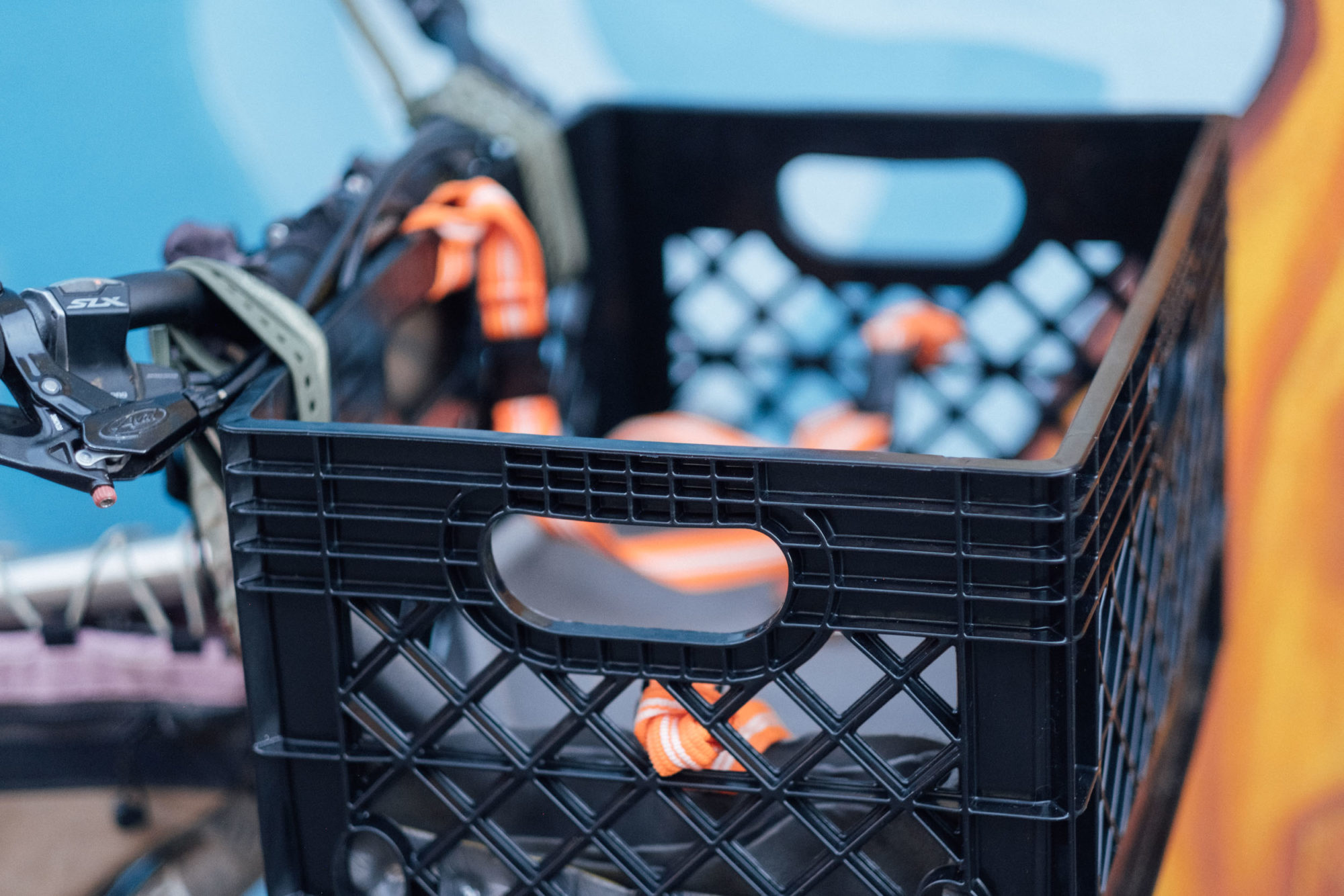
The US milk crate came recommended by friends who haul their dogs in Mexico City. It’s rigid enough to support itself on a platform rack and it’s relatively roomy. The handles are useful for lifting the bike too, though I’d have preferred a crate with a shallower lip to make it easier for Huesos to get in and out. We’ve padded all the edges of the crate and added a cushion for him to lean against, which doubles up well as a luxury pillow in the tent!
The Old Man Mountain Divide is the king of versatility. It can be flipped in either direction, fitted to a bike with existing eyelets or a thru-axle, and has adjustable feet that fit up 29 x 3″ diameter wheels.
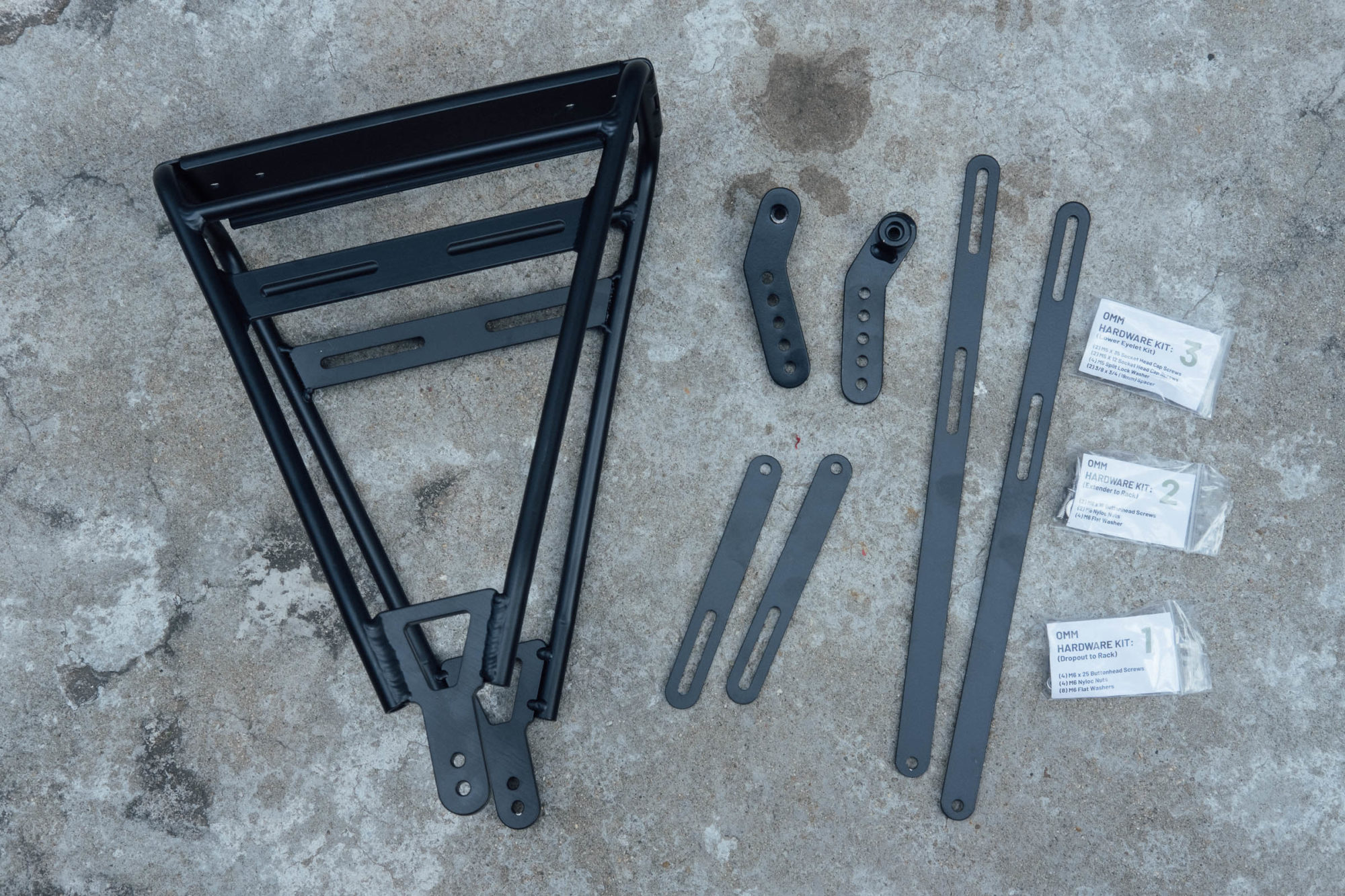
We keep Huesos in place with a three-point attachment system with carabiners, though at this point, two clips work fine – and he may well be just fine without any at all. The straps are kept loose enough that he can shuffle around, but he prefers to lie down rather than sit up straight. We aim not to have Huesos in the crate for extended periods of time, so he can stretch out those long legs of his. Luckily, there are so many low-traffic dirt roads in Mexico that it’s rarely too long before he’s free to lope. Compared to a cargo bike with a larger crate or lower platform, this system isn’t especially efficient – training him to jump in or out would definitely save time in the transitions, as well as reduce the effort needed to lift him up several times a day.
Front or back
And experiment is certainly what I’ve been doing. Initially, I tried the rack on the front of the Jones Plus SWB that I’ve ridden most days for the last two years. The setup felt like the perfect introduction to dogpacking, as I could keep an eye on Huesos, and he could keep an eye on me. We chatted as we rode through town and I ruffled his big ears.

Huesos took to cratepacking quickly, motivated by both the company of other cyclists and the realization that it always culminated in a run. A 27.5 Plus wheelset kept the centre of gravity relatively low and afforded a little suspension too. But there were downsides. My Jones H-Bars prevented me from getting the rack as close as I’d have liked to the headtube, so I swapped them out for a set of Tumbleweed Pursuador alloy bars which tidied up the cable routing too. And as Huesos grew – or at least, became heavier – the front-loaded steering became increasingly hard off-road, especially at slow speeds, or through tight traffic. Unlike a dedicated cargo bike where the heft of your payload is carried by the frame, his weight sat directly on the fork. Plus, a big crate hides the front wheel from view, which makes riding rocky or technical terrain disconcerting.
Instead, I tried the rack at the back of the bike. Despite its name, the chainstays on the SWB – Short Wheel Base – are relatively long, at least by mountain bike standards. But still, it was a tight fit. Given the size of the milk crate and the position of my saddle, I ended up tilting it back slightly to create enough room between my back and the crate. Running the rack at the back means there’s no room for me to wear a hip bag and it also makes negotiating steep descents less confidence-inspiring – running a dropper post definitely helps on singletrack descents. I noticed too that having 20 kilograms of rear payload – Huesos, crate, and rack – makes the front of the bike lift and waver on climbs and that pedaling out of the saddle has a noticeable pendulum effect, even if it doesn’t feel precarious or out of control. As a ballast, I added my BXB handlebar bag and a couple of water bottles, along with a Tubus low rider to add in a couple of small panniers for campouts.
It’s true that lifting him into the crate requires a twisting action that would make my chiropractor wince. Even so, it feels like a very viable and versatile option for now, especially I added in a dynamo hub, so I could use the “crate bike” for shopping duties and evening rides too. Add in a 28T front ring for the 11-50 cassette – I definitely needed help with those knee-popping, high country climbs – and I felt like our impromptu setup was dialed. We were out there roaming the dirt roads of Oaxaca!

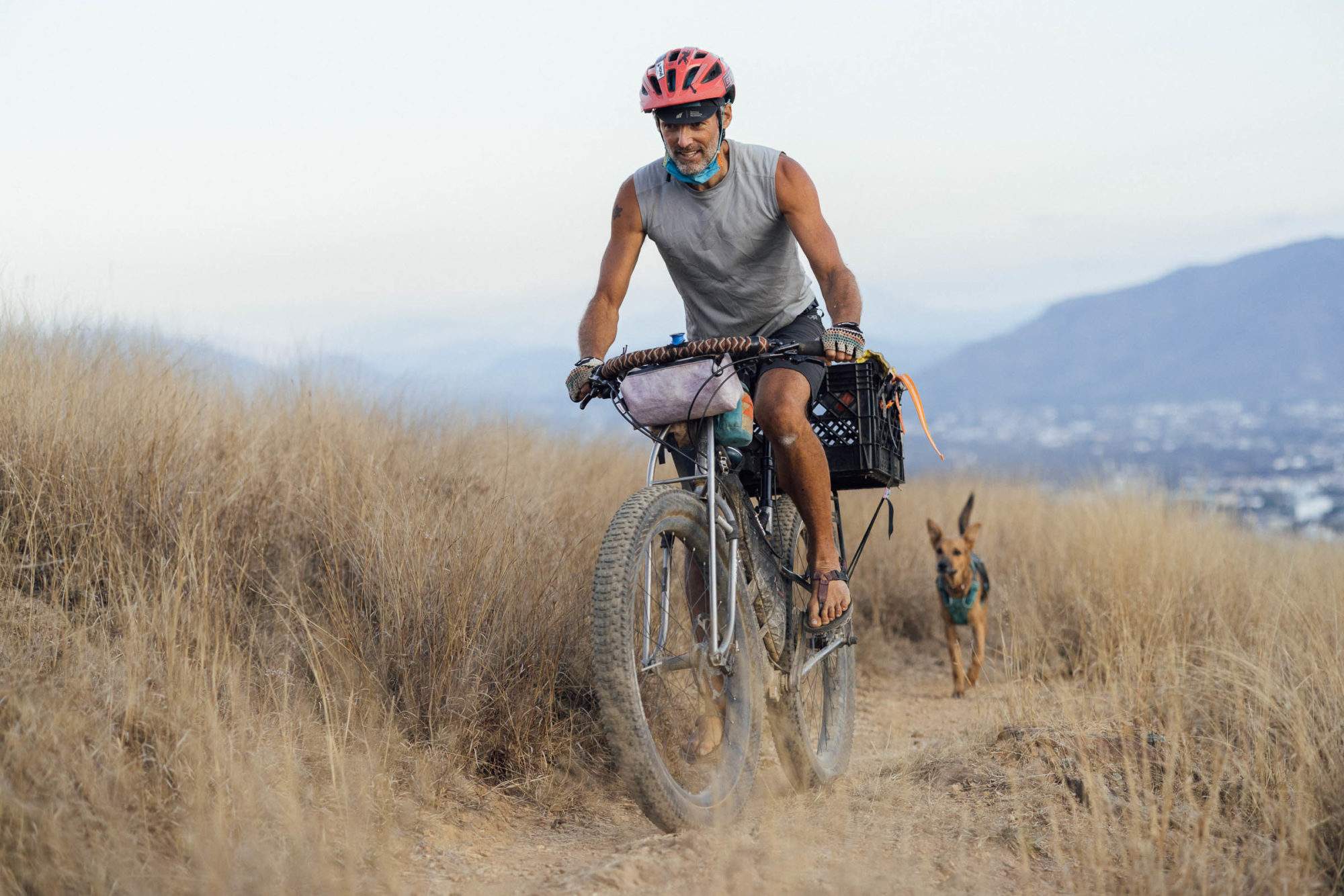
Invariably, however, curiosity got the better of me, so next I deployed the additional Old Man Mountain thru-axle and fitted the rack and crate to a Jones Plus LWB, hoping for a little more room to shift my body weight while riding trails. The LWB is a bike that I’m lucky enough to be borrowing right now, especially as this particular specimen centres on a gorgeously supple titanium Spaceframe and cushy 29 x 3.25″ tyres. Oaxaca is mined with steep and rowdy trails – unladen, the LWB is a joy to ride, be it for climbing technical trails or hurtling down them. I have to admit, however, that it isn’t exactly designed with dog hauling in mind. Even if I welcomed the added standover from the Spaceframe, its rear triangle flexed under such a heavy load. Still, it was a good proof of concept because its longer wheelbase definitely held some real advantages. As I hoped, it afforded me valuable real estate between my backside and the crate, and it made the bike more stable when tackling the rough climbs that I struggled on with its shorter sibling. What’s more, those monster wheels added noticeably to both my comfort and Huesos’, even if their sheer height made lifting him into the crate harder than on the SWB.
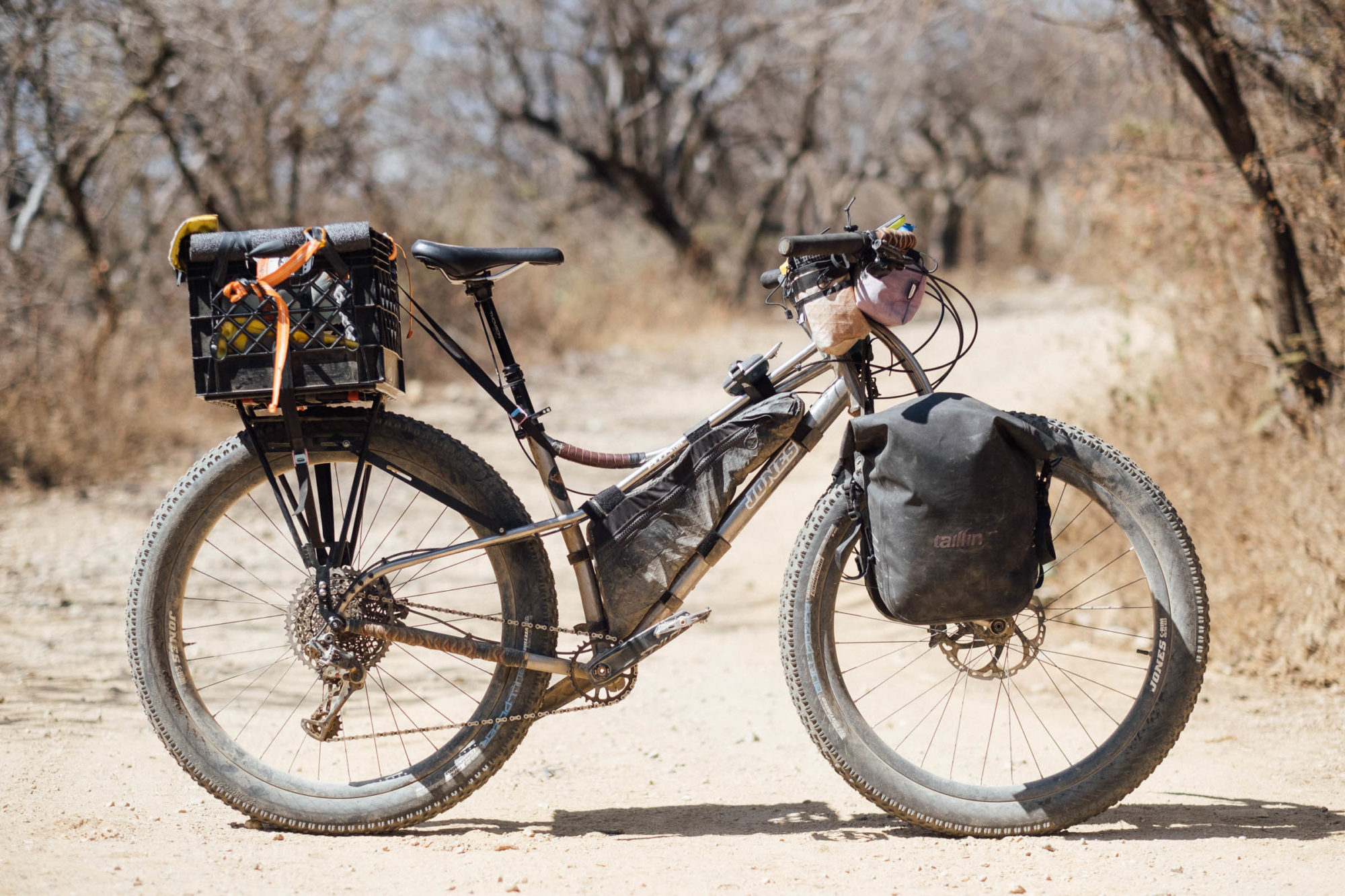
Pros and Cons of front and rear cratepacking setups
- Nice to chat to Huesos when he’s up front
- Satisfies his curiosity to see where we’re going
- Easier to load him in when I’m by myself, as I don’t have to twist my body
- Easier to get off the back of the bike on the steeps
- Can’t see front wheel on trails and rough roads, which is a bit disconcerting
- Tricky to get up curbs with so much weight in the front
- Harder to steer at slow speeds – both trails and traffic
- Lighter front steering feels better off road, though a little weight on the fork is needed to balance the bike out
- Noticeably smoother ride at the back
- Protected from the wind
- Reaching back and scratching those big ears feels good too
- Tricky to load him into the crate quickly
- Need to be more limber to throw a leg over the sadle
- Depending on the bike, not much room between the crate and the saddle
Given that the Divide rack can be mounted to most unicrown forks or rear triangles – with or without rack eyelets – trying both out is relatively easy to do. I can see advantages and disadvantages to both, depending on the geometry of your bike, the size of your dog, and where you like to ride most.
Chainstay wars
For those interested in numbers, a Jones Plus LWB has chainstays that are over 30mm longer than a SWB – 483mm compared to 449m. Further research has revealed, however, that the same company’s latest model – the LWB HD/e – has the longest of them all! With 505mm chainstays, this may well make it the perfect, ‘standard frame’ for off-road dogpacking candidate, especially as it also features a stiffer, beefier tubeset too. By way of comparison, a Surly ECR sports chainstays that are 450mm in length and a Tumbleweed Prospector rings in at 456mm. At 545mm. Rivendell’s elongated Gus Boots Willsen looks to be a very interesting contender too, if you can live without disc brakes. Of course, they’re all dwarfed by midtails and longtails – a Salsa Blackborow has stays that are 650mm long and a Big Fat Dummy sports gargantuan 850s – though such bikes are often less practical on public transportation.
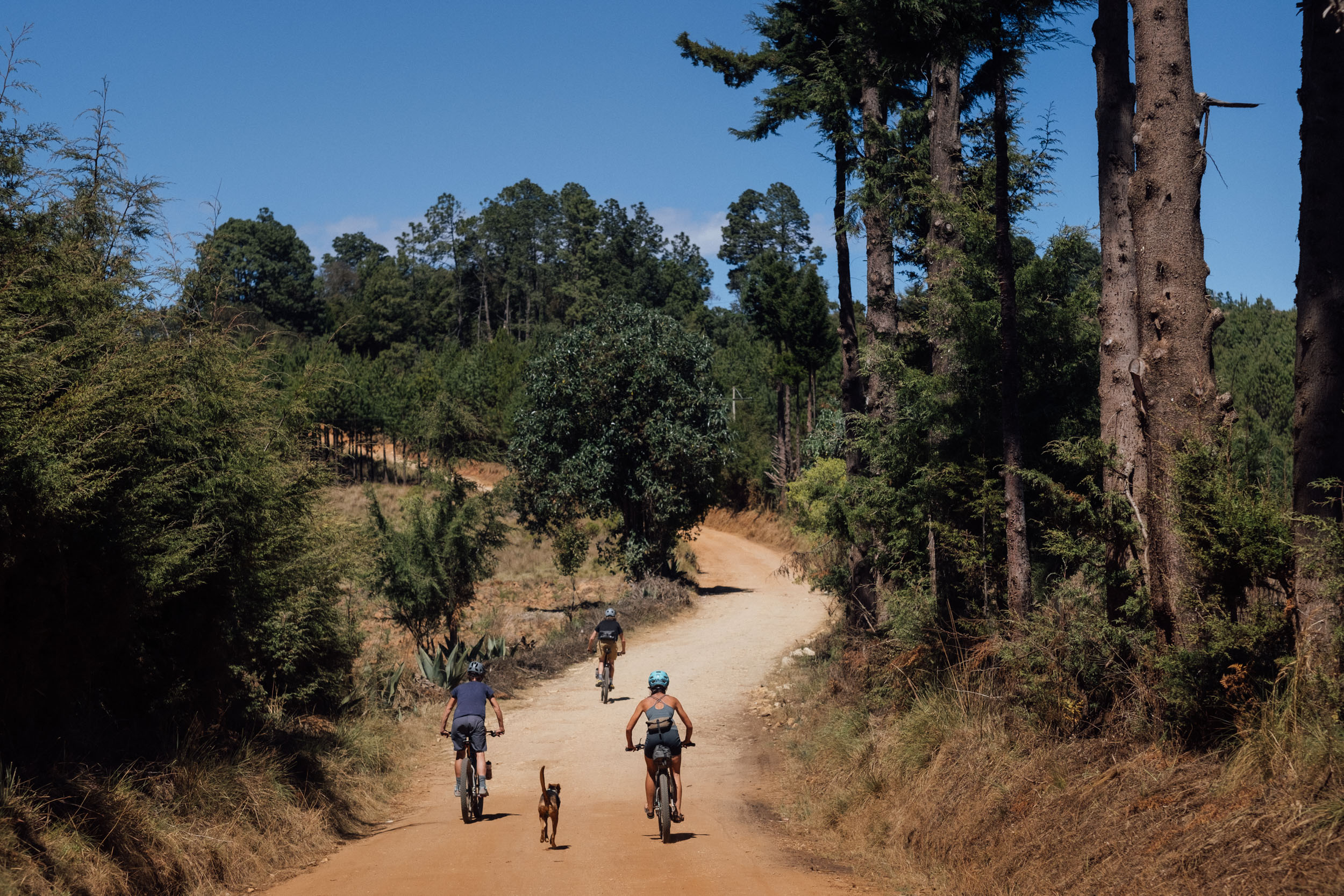
Simple pleasures and canine roadblocks
Ultimate setup conundrums aside, trying out these different options has been a great excuse to get out on a number of shakedown campouts, and more recently, a three-day Mitla Valley ramble and a Cuatro Venados overnighter. Huesos, Emma, and I even had the pleasure of Logan and Gin’s company, here to escape some of the North Carolinan winter.
Dogpacking in Mexico brings its own particular challenges and adds a dynamic to a trip that I’d never experienced before. Street and countryside dogs are almost everywhere to be seen, either barking cantankerously from rooftops, wiggling excitedly under fences to take chase, or even roaming the land in misfit packs. Such roadblocks required us to coordinate, corral and coax Huesos forwards on more than a few occasions, cheering him on enthusiastically when we all made it through. Our rewards? Huesos lavished us with his attention in equal measure – Logan and Gin were especially delighted when he leaped into their tent to say his good mornings. After all, it’s hard not to be swept away by his perma-grin, his endearingly awkward legs, those vocal squeaks of his, or his endless enthusiasm for strokes.
I love bicycle touring in all its forms, whether it’s a solo endeavor, with friends, my partner, my mum, my son, or now ‘my’ dog. Travelling by bike is my way of connecting more meaningfully with the places around me and creating a deeper bond with the people – or the furry creature – that I’m spending time with. Sure, looking after Huesos is a commitment, and I sometimes wish he was that little bit smaller and lighter on the scales. But I also can’t imagine a dog in my life other than Mr. Legs, and seeing him bound alongside me on the bike, tongue flapping wildly in the wind and ears tucked back into his little head, is about as heartwarming as it gets. I guess in Mexico you don’t always choose the dog – it chooses you. And I’m pretty thrilled to have Huesos along for the ride.
If you’d like to adopt your own Huesos, there are organisations around the world that work to rehome abandoned dogs. In Oaxaca, I have Friends of Megan and Caravana Canina to thank for doing such a wonderful job.
Related Content
Make sure to dig into these related articles for more info...
Please keep the conversation civil, constructive, and inclusive, or your comment will be removed.






